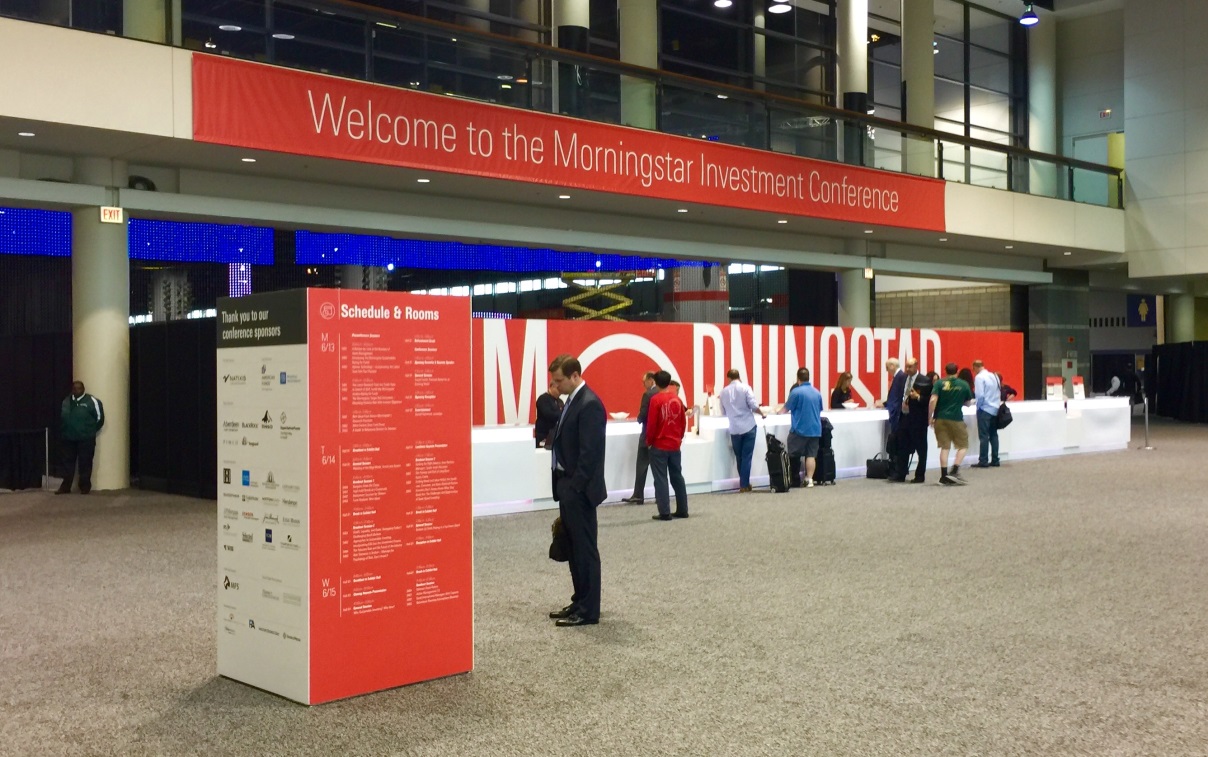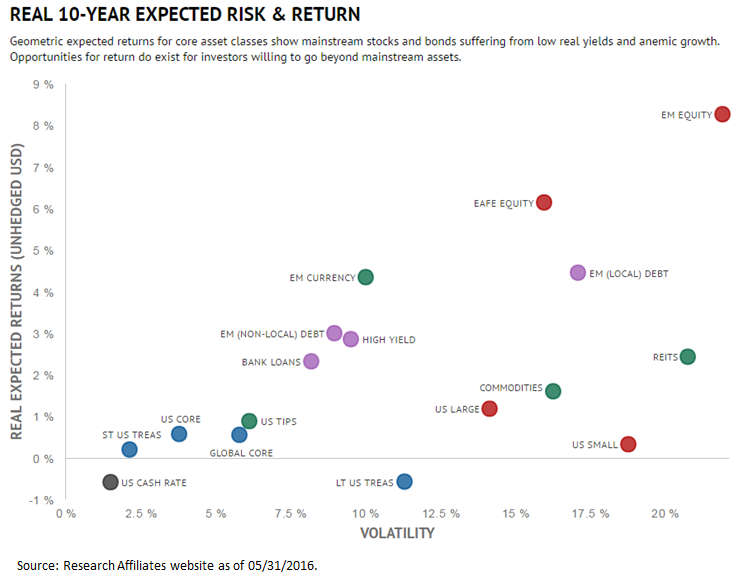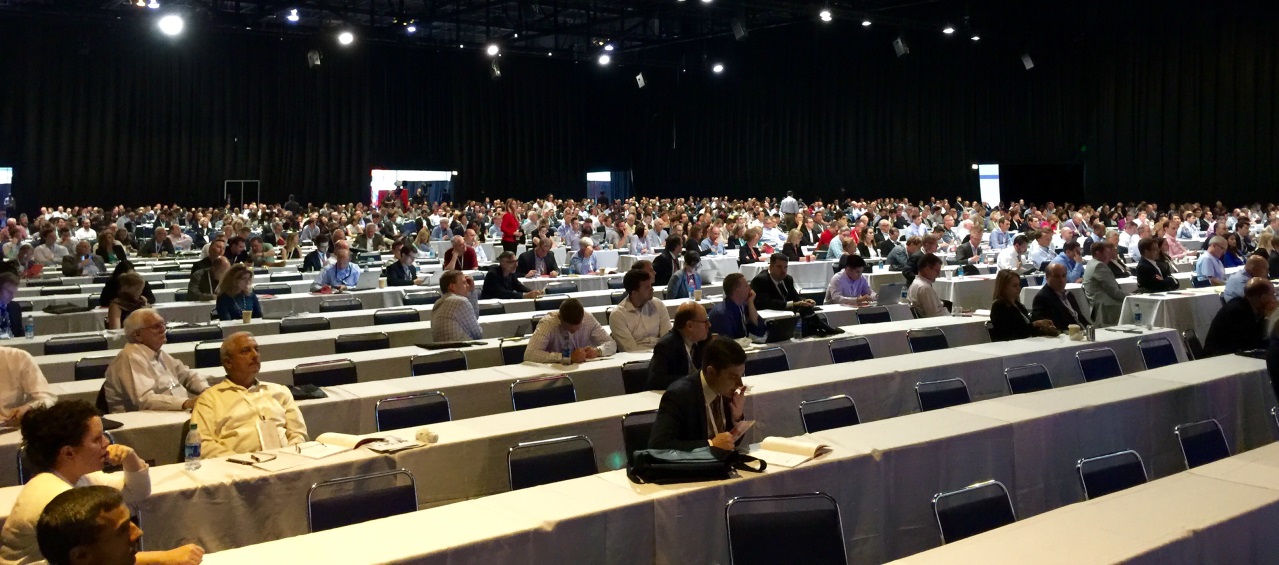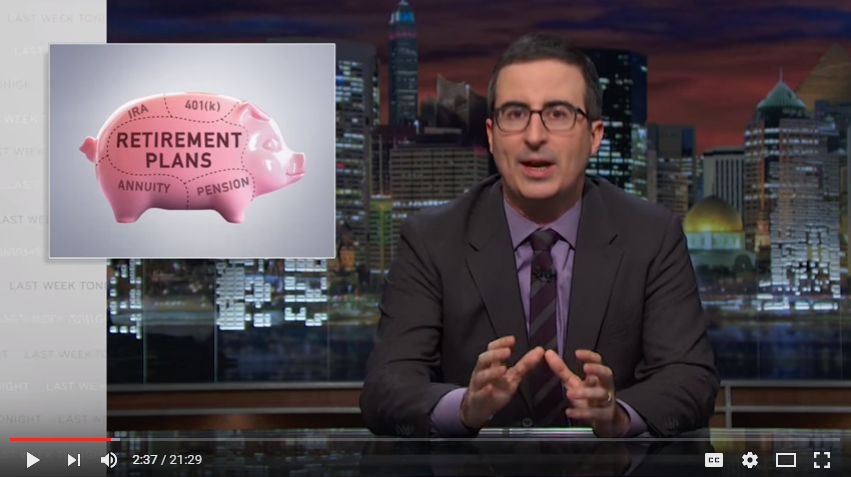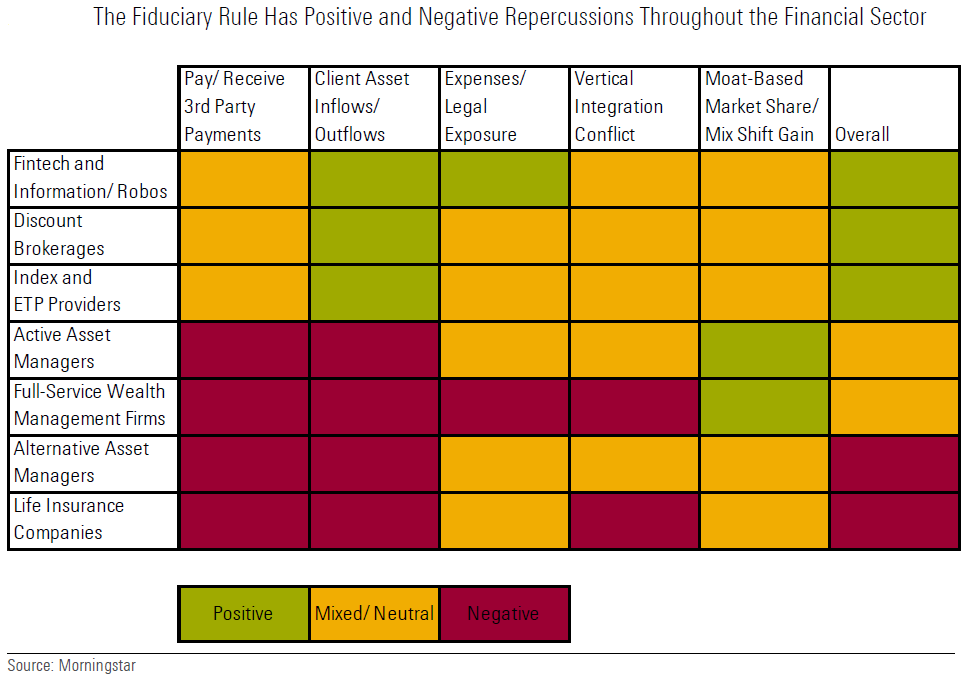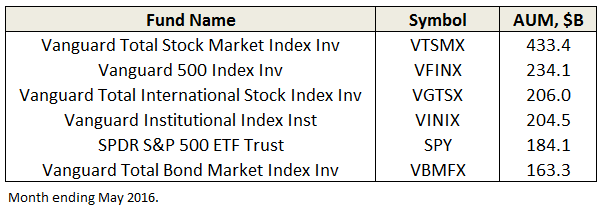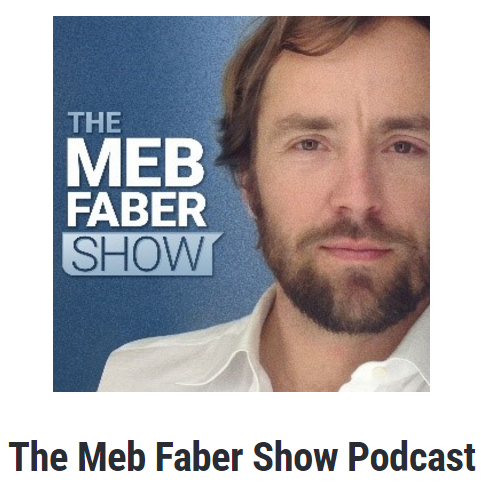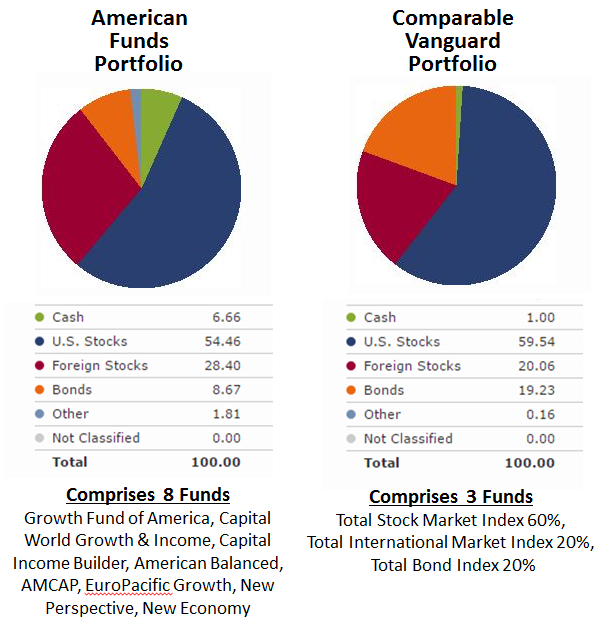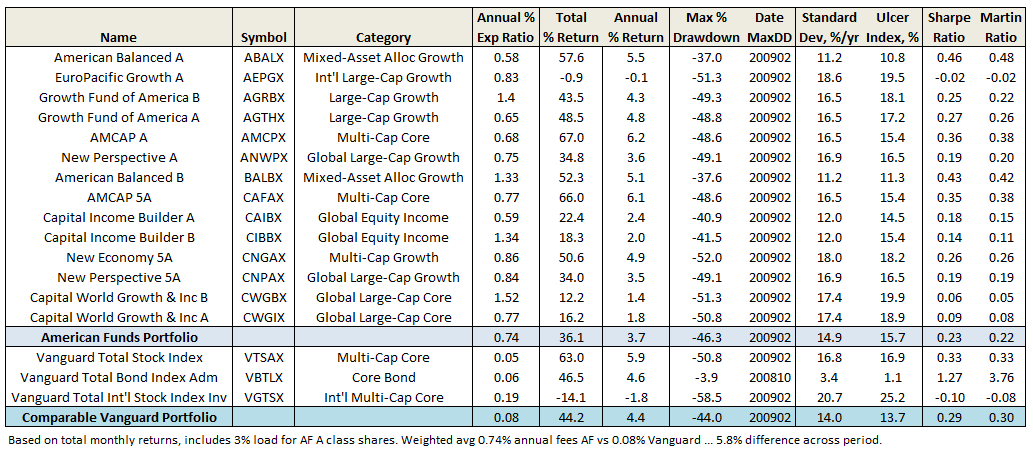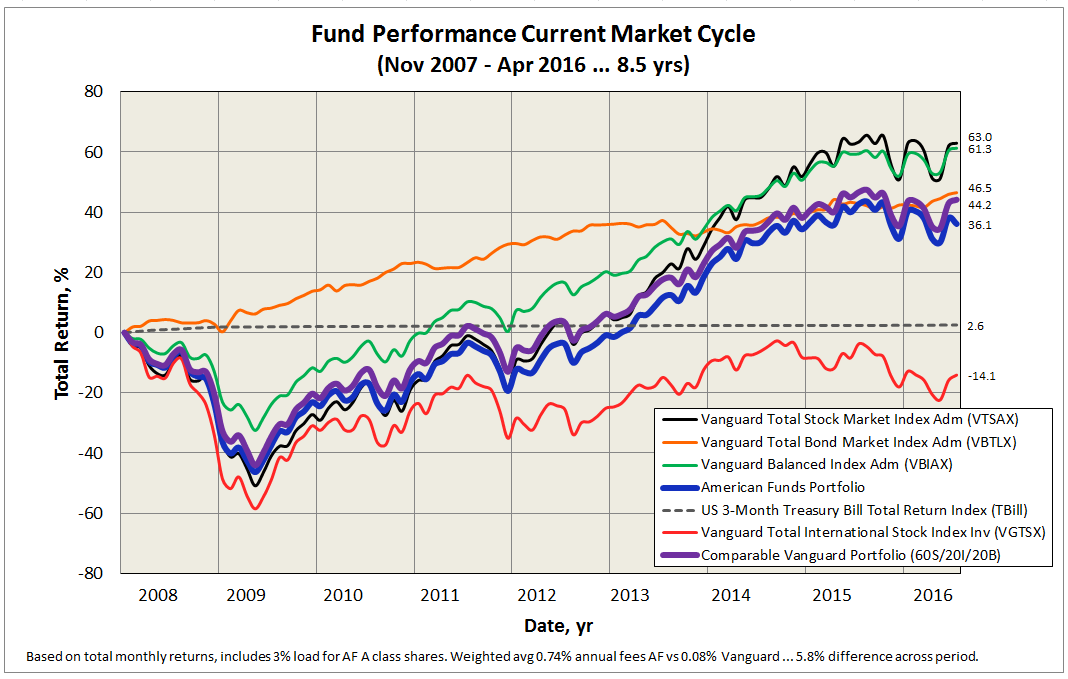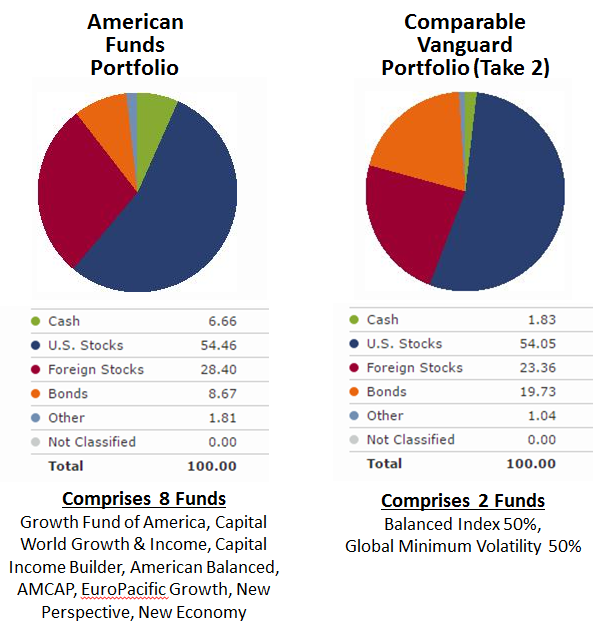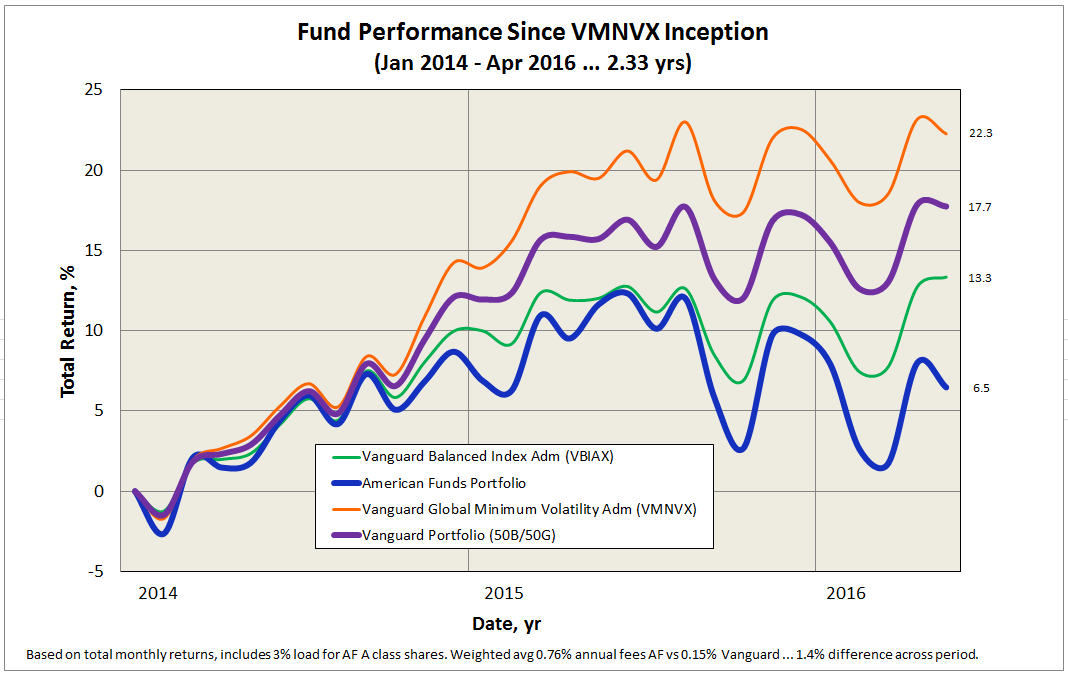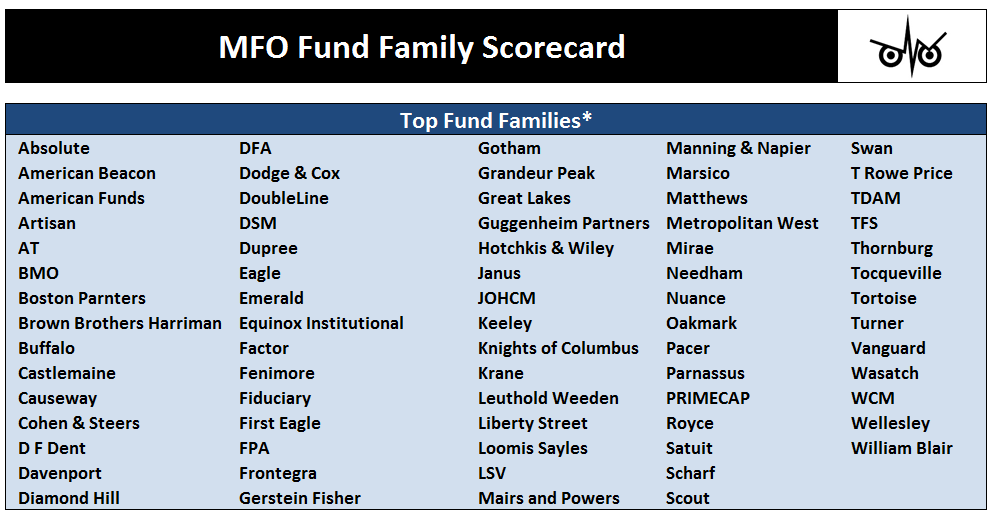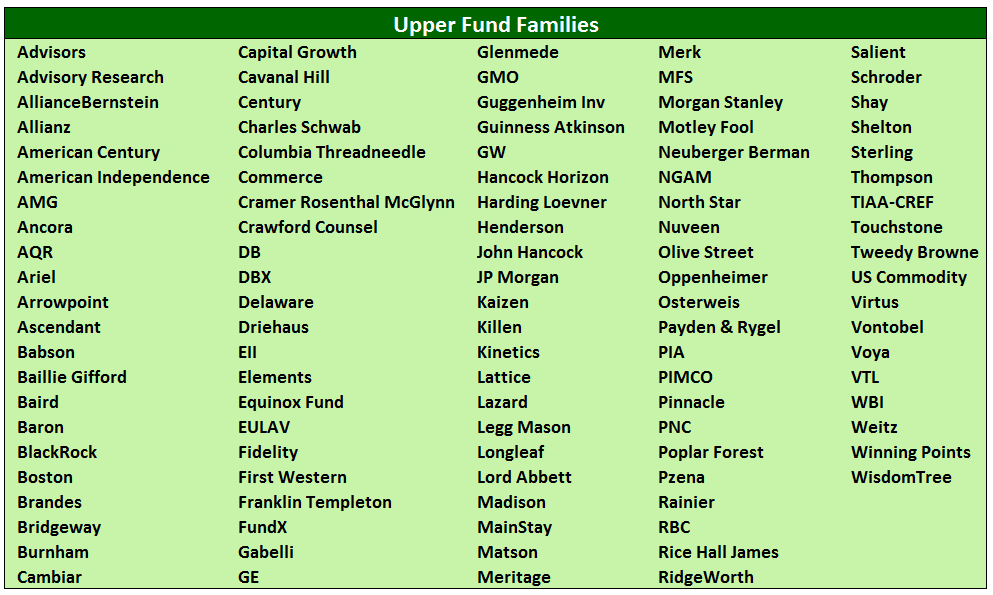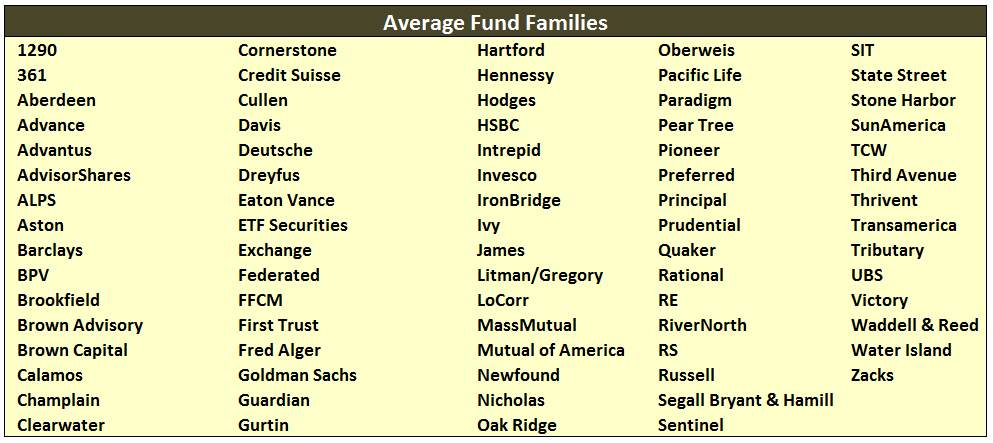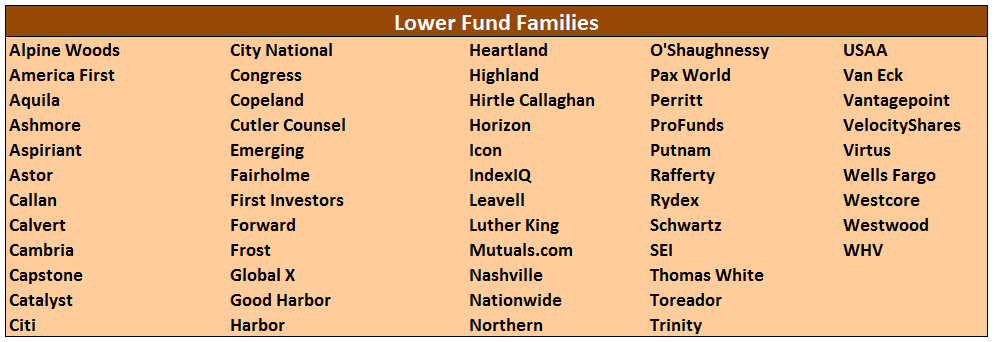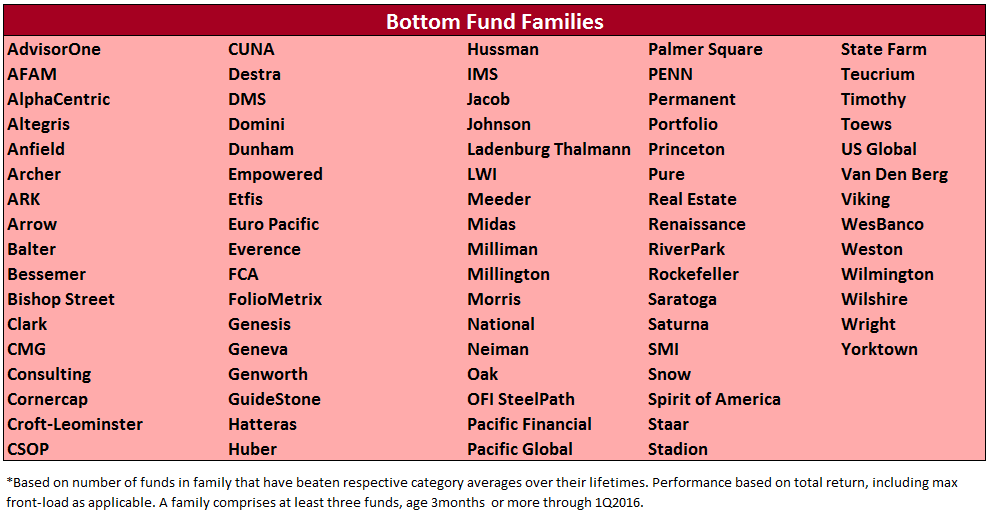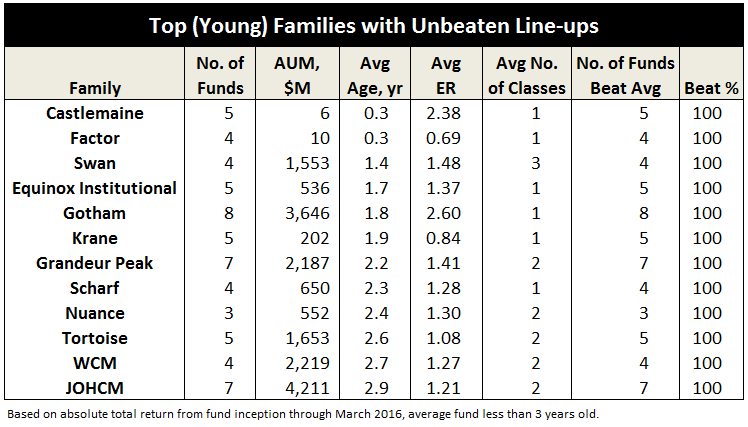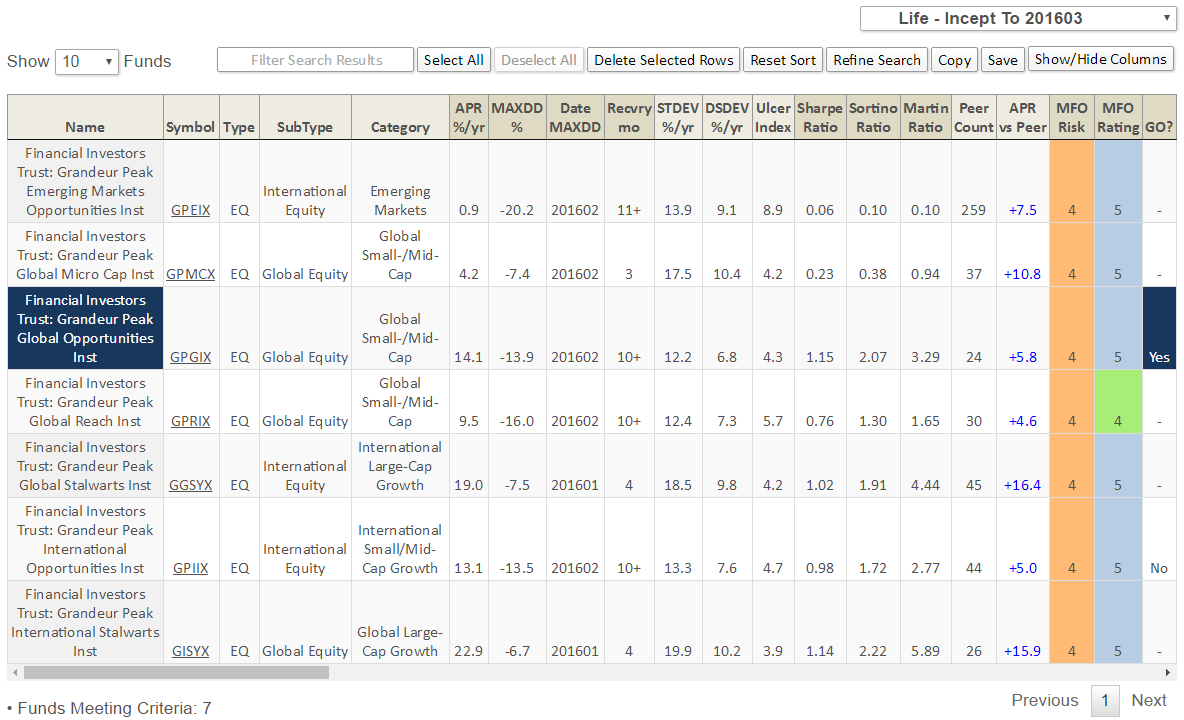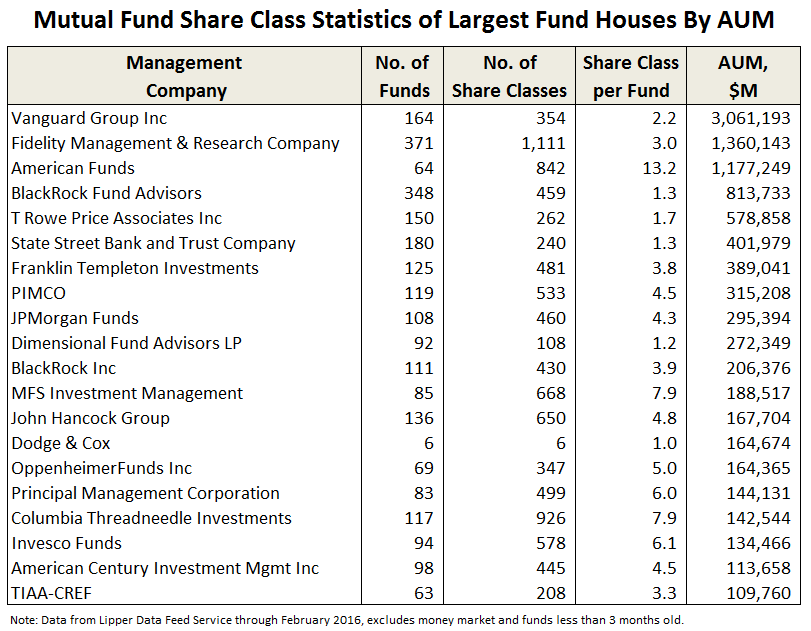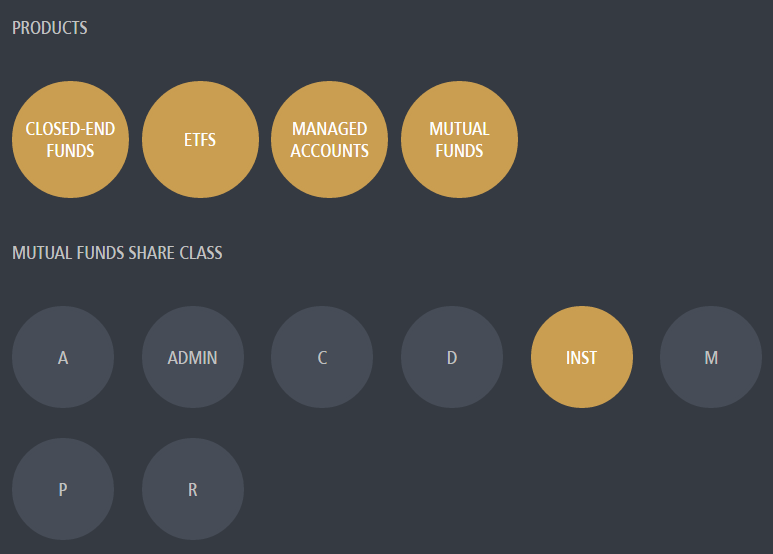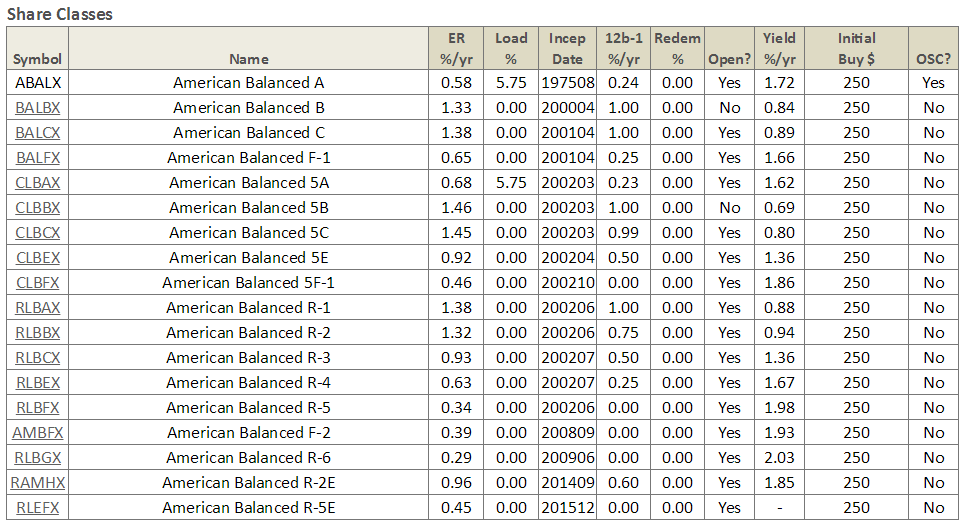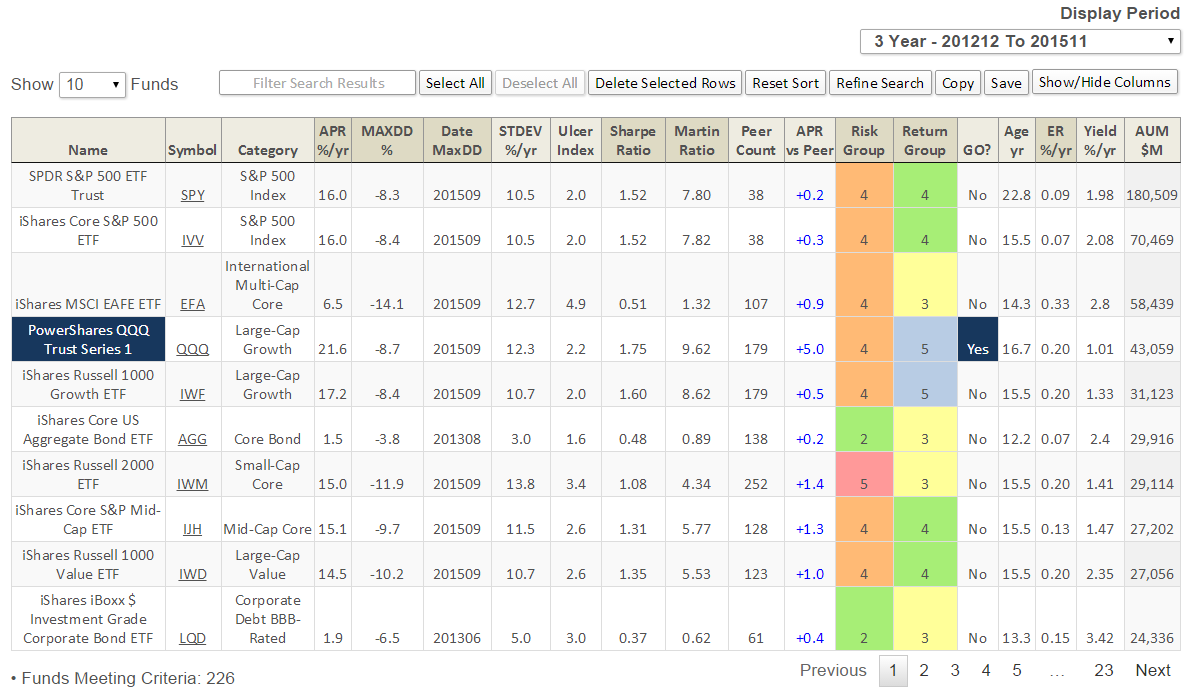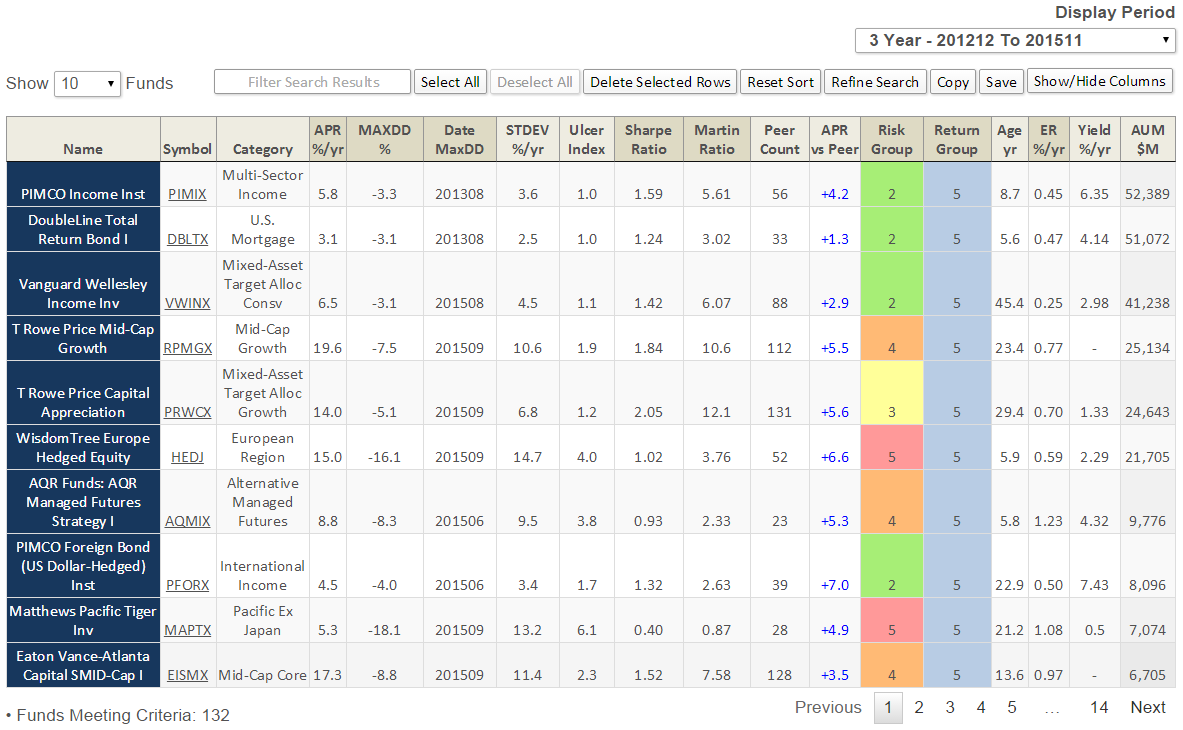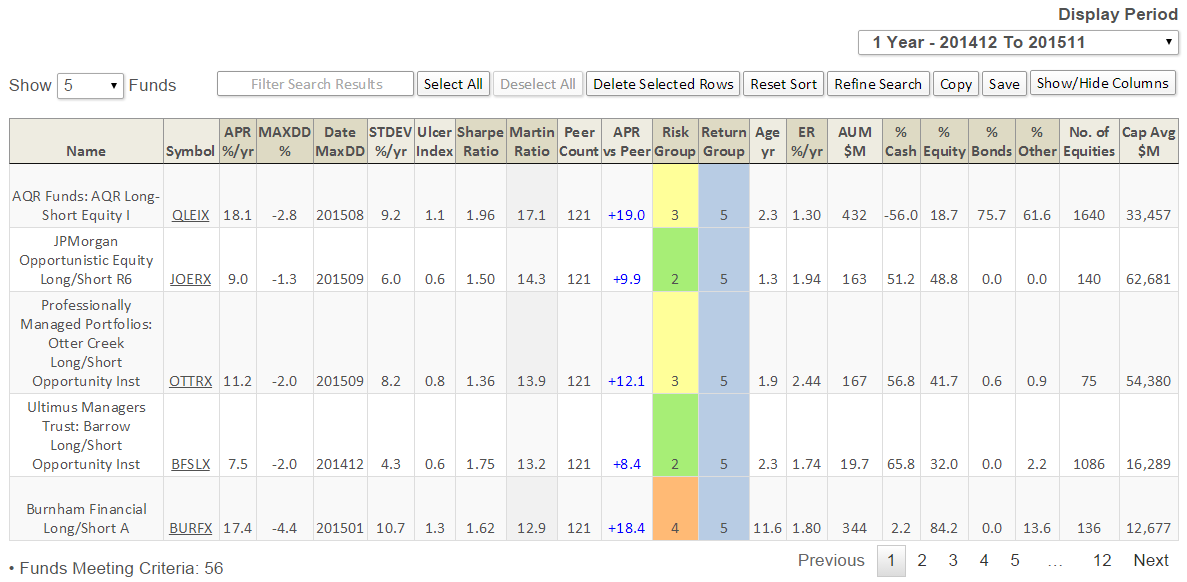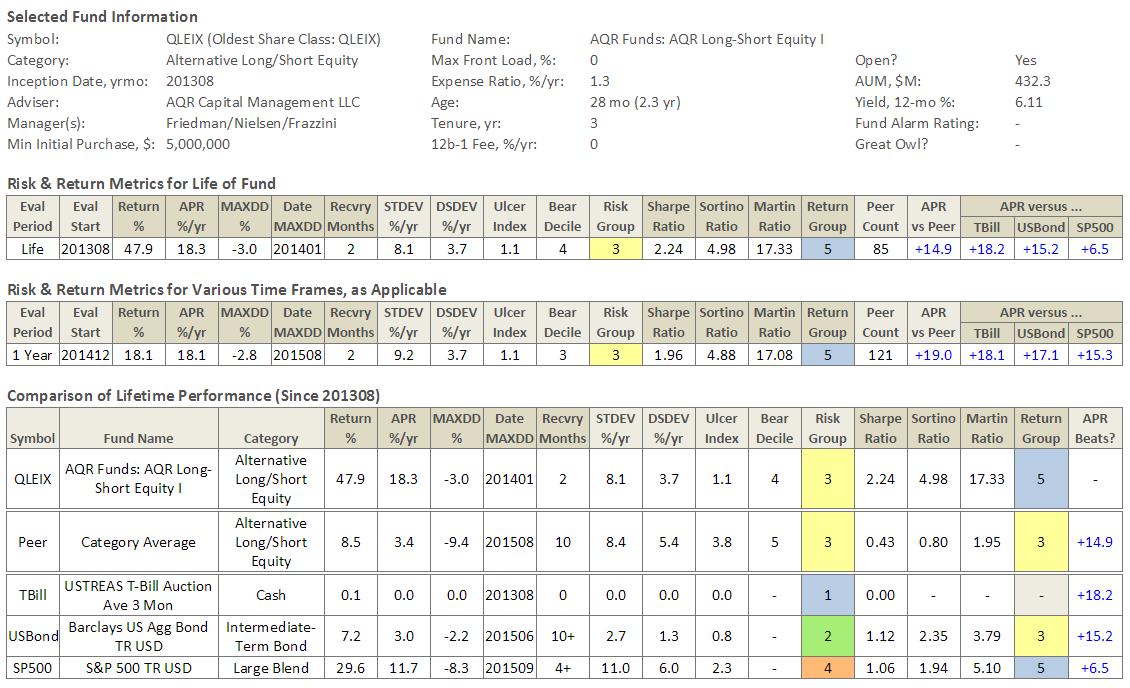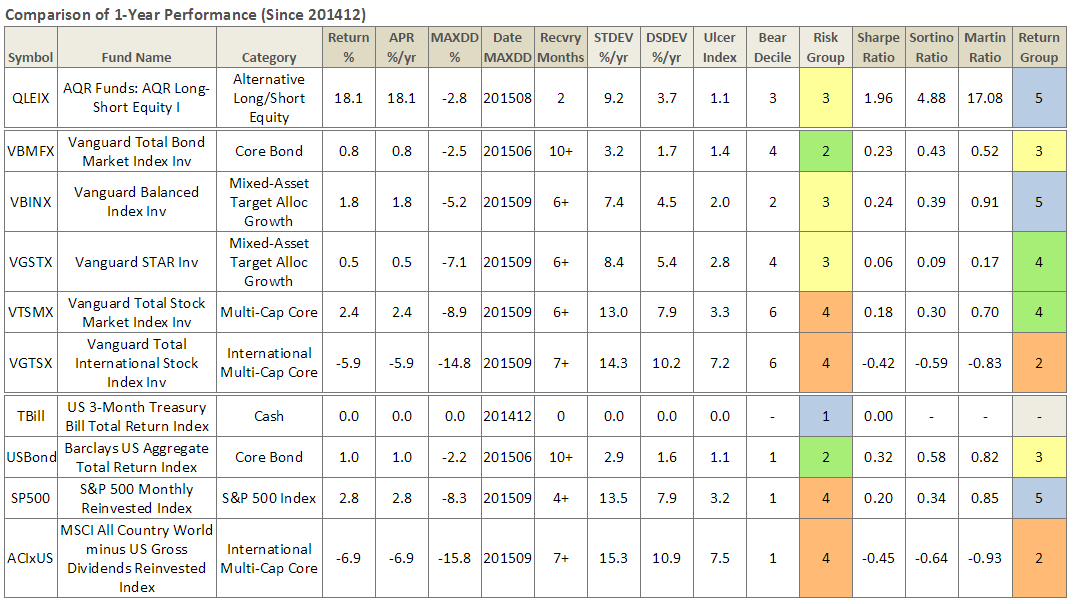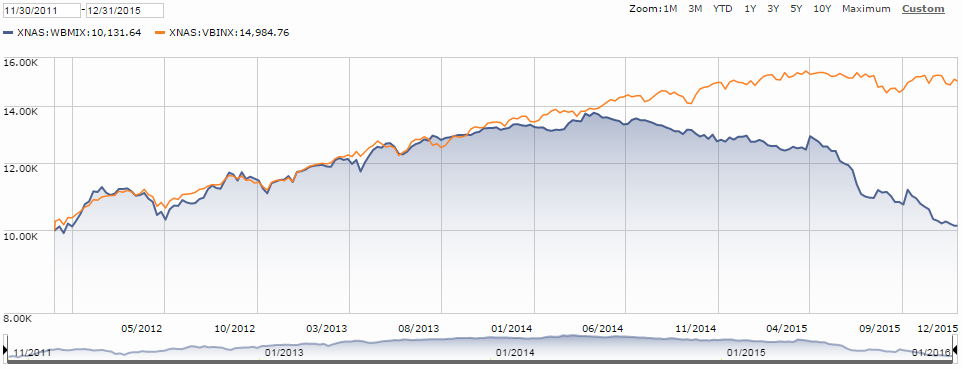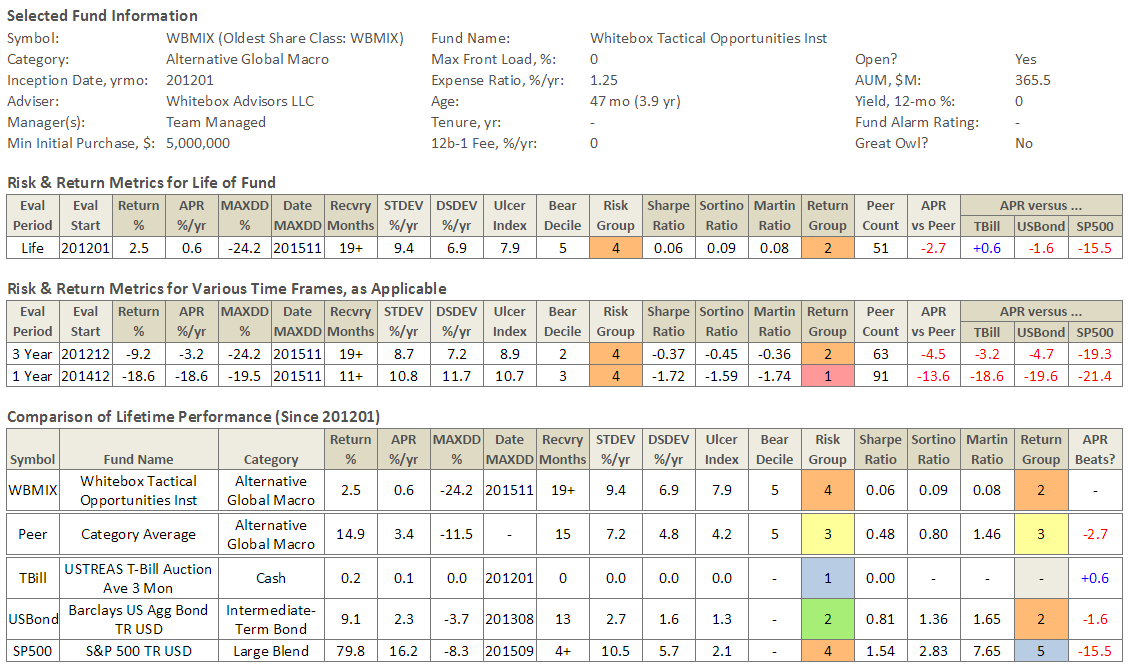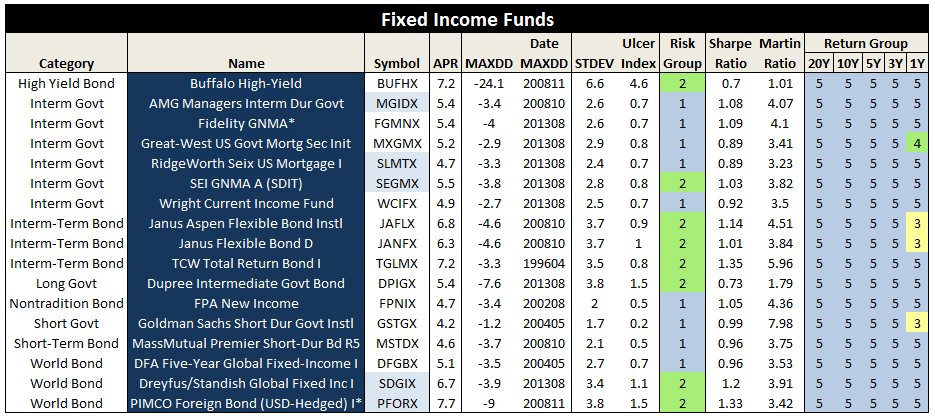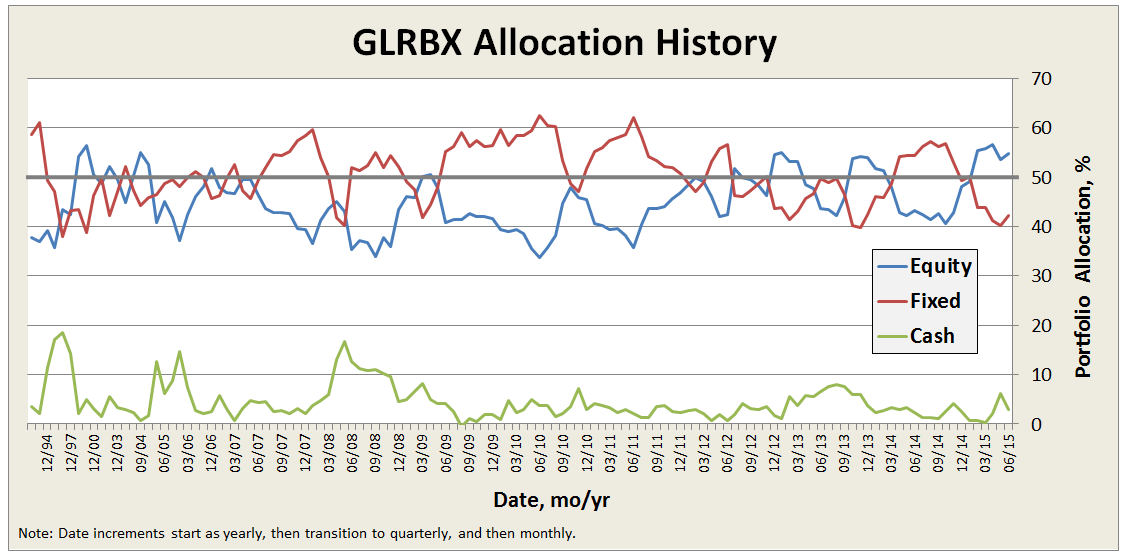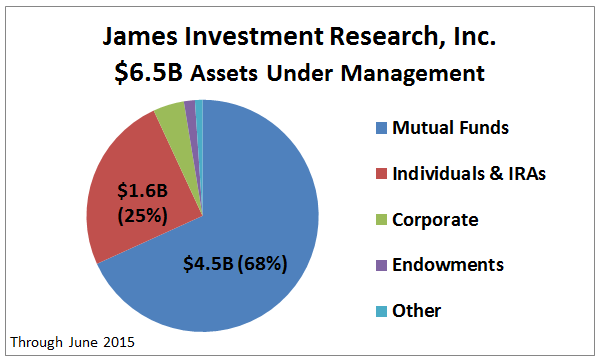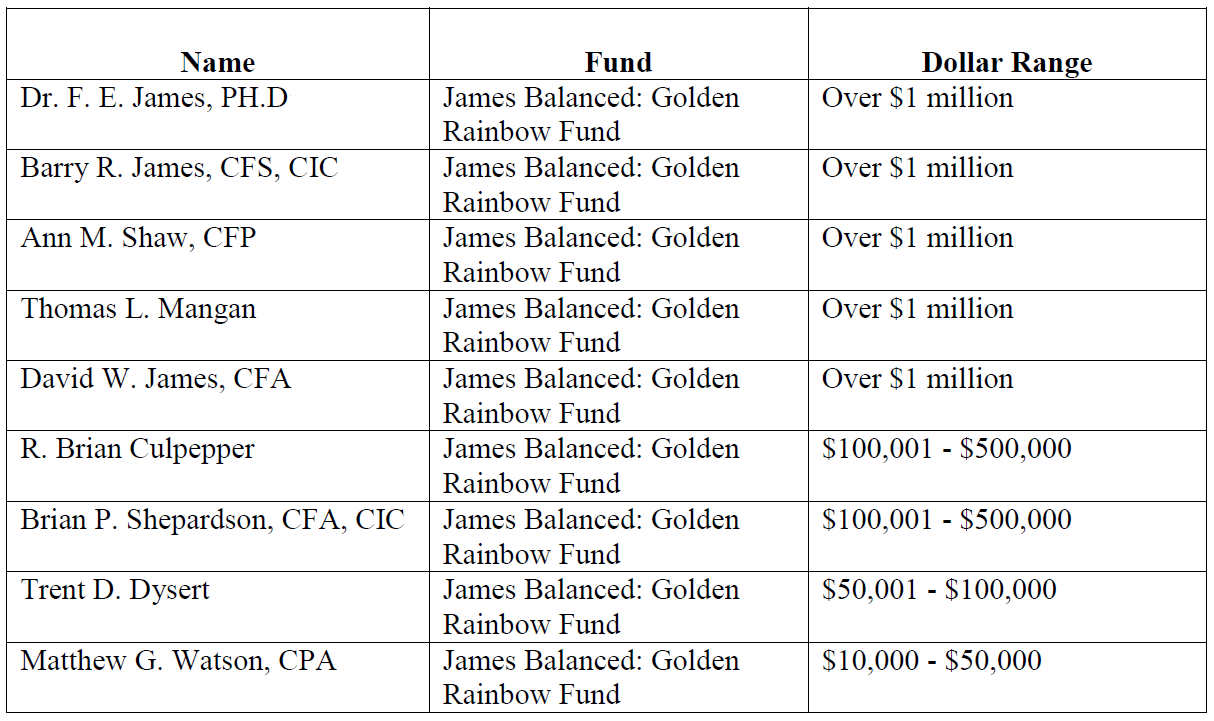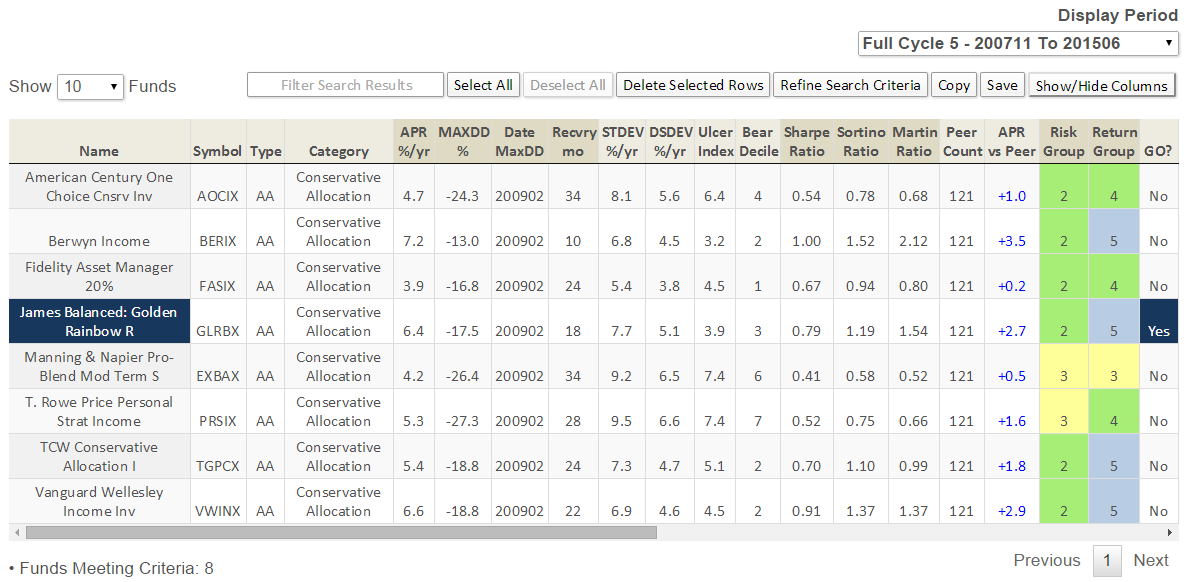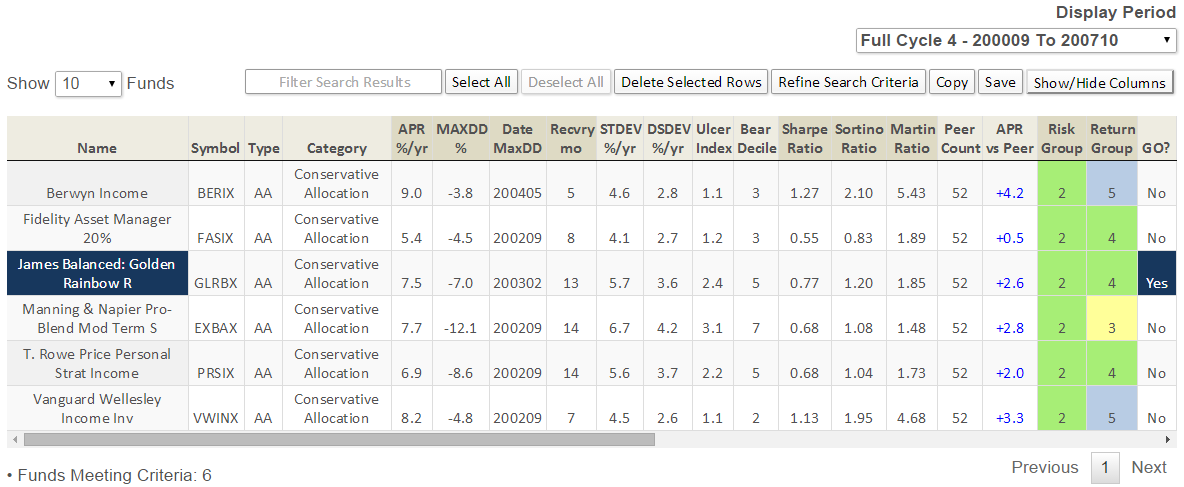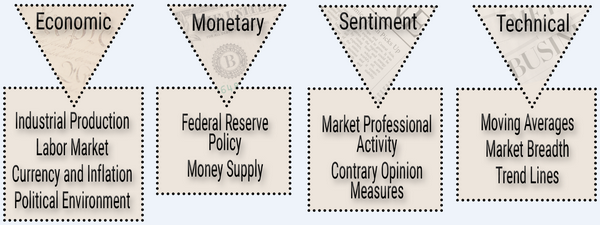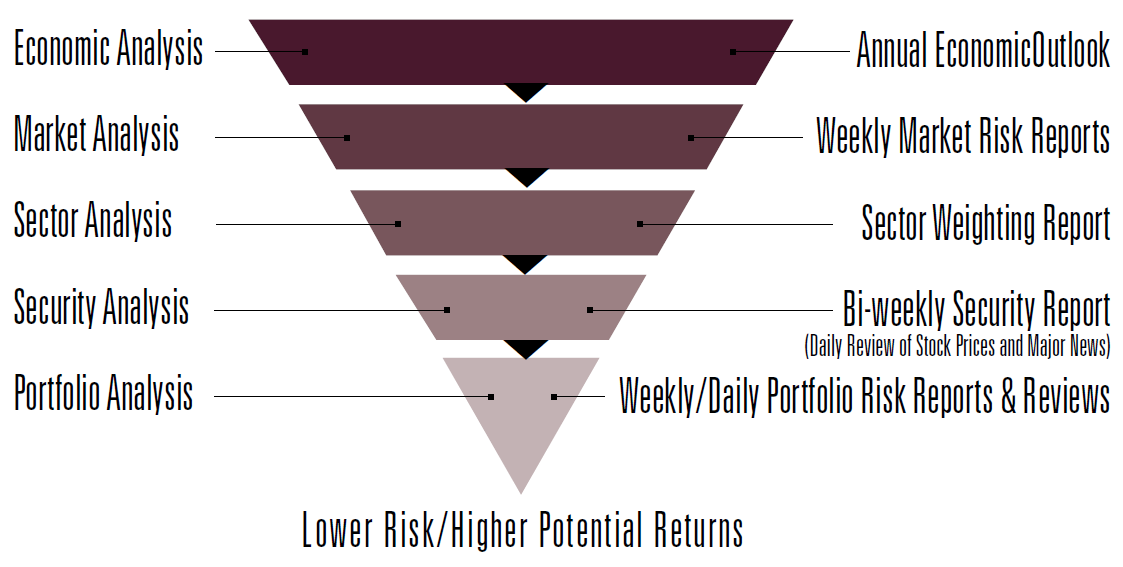USAA was founded in San Antonio, Texas, when 25 Army officers decided to insure each other’s automobiles. The year was 1922. Its original name: United States Army Automobile Association. Today, USAA stands for United Services Automobile Association – a Fortune 500 diversified financial services organization that caters to US military personnel and families. It has more than 11 million members. Its chairman is retired General Lester Lyles. Why choose to invest with USAA? “Military Values: Our disciplined approach stems from our military values of service, loyalty, honesty and integrity.” Continue reading →
Category Archives: Charles
Vanguard’s Quantitative Equity Group
Our colleague Ed remained curious about Vanguard’s Quantitative Equity Group (QEG) after we reported on our brief conversation with John Ameriks, head of QEG, at Morningstar’s ETF Conference last month. So, we reached out to Vanguard with a few follow-up questions. Continue reading →
Morningstar’s ETF Conference – Chicago 2016
The good folks at Morningstar hosted the seventh annual ETF conference in Chicago, its global headquarters, this past month. More than 650 total attendees, including more than 500 registered attendees (mostly advisors), more than 80 sponsor attendees, nearly 40 speakers, and more than 30 members of the press. An increase from last year.
The Diversified Portfolio of Less Correlated Asset Classes
“… over the long term the benefits offered by diversifying a portfolio of less correlated asset classes can be significant … investing in a diversified portfolio across equity and fixed income is the best option for most individuals,” wrote Jeremy Simpson in 2015, then director of Morningstar Investment Management in the article The Benefits of Diversification.
In Mebane Faber’s classic The Ivy Portfolio, he cites multiple sources on the benefits of diversification Continue reading →
Fund Facts
At the recent Chicago conference, Morningstar’s Gregg Warren stated that asset management remains an attractive business because of steady fees, high operating margins, low start-up costs, and because “investment inertia is its best friend.”
Through June there were 281 funds with assets over $10B, including 8 that have trailed their peers in absolute return by at least 1.7% per year during the current market cycle since November 2007, or about 14% or more in underperformance. (See table below, click on image to enlarge.) Most are bottom quintile performers, trail nearly 90% of their peers, and four are Three Alarm funds. They include Templeton Growth (TEPLX), Thornburg Investment Income Builder (TIBAX), Davis New York Venture (NYVTX), Fidelity Magellan (FMAGX), and American Funds’ Bond Fund of America (ABNDX) and Intermediate Bond Fund of America (AIBAX). The folks invested in these funds certainly can’t be accused of chasing returns. Continue reading →
Morningstar Conference: Grasping at Straws, Department of Labor’s Fiduciary Rule, and Vanguard CEO McNabb
During our annual (sometimes bi-annual) excursion to Chicago this past month, I was reminded of the old adage:
“We see things not as they are but as we are–that is, we see the world not as it is, but as molded by the individual peculiarities of our minds.”
Quickly followed by:
“It’s better to be uninformed than misinformed.”
Company President Kunal Kapoor started the first day general session by showing Morningstar’s Market Fair Value metric … “It says the US market is fair valued.”
Gold-star fund manager Michael Hasenstab of Templeton Global Bond (TPINX) stated that “we are at a pretty rare point in markets where you have huge dislocations … unprecedented and untested monetary policy experiments creating tremendous amount of volatility.” The Fed will inevitably be raising rates, due to inflation and a labor market with little or no excess capacity. He is negative US Treasuries (“valuations nowhere near justified”), but sees “real upside opportunities in select emerging markets … the most unloved asset class.”
Later the same day, famed author and investing advisor Bill Bernstein stated that “I do find foreign equities valuations more attractive. Of course, there is good reason for that. Stocks don’t get cheap without good reason.”
The day two general session featured a polite debate called “Meeting of the (Big) Minds: Arnott and Asness.” Mr. Arnott’s firm Research Affiliates maintains an Asset Allocation site that provides 10-year Expected Returns across various securities and asset classes. The bottom-line: near zero real return expected for traditional asset classes. “Valuations matter,” he explains. He sides with Professor Shiller that US equities based on historical norms are currently overvalued.
During a sidebar with Tadas Viskanta, founder and editor of Abnormal Returns, he offered his impression of the conference: “Grasping at straws…”
Our colleague Ed Studzinski later added: “Half the people in this room will not be here five years from now.”
How many people were there? 2016, including 831 paid advisors, 581 exhibitors, and 43 speakers.
Why might Ed think the attendance will be under pressure? I’ll offer two reasons: The Department of Labor’s (DOL’s) Fiduciary Rule and Vanguard; basically, the two elephants at the conference.
As background, please reference:
- Fact Sheet – DOL Finalizes Rule To Address Conflicts of Interest In Retirement Advice, Saving Middle-Class Families Billions of Dollars Every Year.
- “Why Vanguard Will Take Over the World,” by our colleague Sam Lee from October 2015 commentary.
The new fiduciary rule requires investment professionals, consultants, brokers, insurance agents and other advisers “to abide by a fiduciary standard—putting their clients’ best interest before their own profits.”
Patrick Clary, Chief Compliance Officer at AlphaArchitect (former USMC Captain, a Harvard MBA, ops/complinance ninja) puts the meaning of fiduciary in proper perspective in the insightful March 2015 post “Distribution Economics – Understanding Wall Street’s Conflict of Interest Problem”:
Fiduciary responsibility matters in financial services more than in any other product category outside of urgent medical care. Shouldn’t this fiduciary have your best interests at heart? Just as you don’t want your doctor to receive kickbacks from Pfizer for overdosing you on Oxycodone, why would you want your financial advisor–or their institution–to receive kickbacks for overdosing you on inefficient, overpriced, investment product that probably won’t help you achieve your investment goals?
HBO’s John Oliver recently gave a more humorous but no less accurate account (click on image to play YouTube video):
In the same session where Bill Bernstein spoke, Morningstar’s Don Phillips warned the fiduciary rule will usher in an “era of blame … litigation heaven.” And in fact, several groups have filed suit against implementation, which is scheduled to become effective initially April 2017, with final compliance required by 1 January 2018.
During the conference break-out session “The Fiduciary Rule and the Future of the Industry,” analyst Michael Wong presented an assessment of impact of rule on financial industry:
He predicts three main trends:
- The movement to fee-based from commission-based full-service wealth management accounts.
- Adoption of robo-advisors and digital advice solutions.
- Shift to relatively lower-cost passive investment products from actively managed.
Morningstar was kind enough to share the session’s presentation charts, here.
Here is a telling example of landscape investors face today. Lipper identifies 42 funds in the category “S&P500 Index,” oldest share class only, at least three months old, as of May 2015. The expense ratios range from less than 20 basis points for funds offered by Vanguard, State Street, Schwab, Northern Funds, Fidelity, Blackrock, and DFA to nearly 60 basis points and higher for funds offered by Legg Mason, Great-West, and Nuveen.
Hard to see how any advisor “acting as a fiduciary” could recommend the funds with the substantially higher expense ratios.
Lipper shows 693 US large cap equity funds, but exclude the S&P Index and other index funds, the number is 532. There are more actively managed large-cap funds than stocks traded in the S&P500! Some industry experts believe the fiduciary rule will help flush out “closet indexers.”
Similarly, Lipper shows 2,447 US Equity funds, which is nearly as many funds as there are equities in the Russell 3000 Index, representing 98% of the US public equity market. How can that be? David is fond of enlightening us: “… 80% of all funds, active and passive, could vanish without any loss to anyone other than their sponsors.”
Maybe Ed has underestimated.
Michael Wong reports: “We’ve already seen the exit of several foreign banks (Barclays, Credit Suisse, Deutsche Bank) from the U.S. wealth management landscape, sale of life insurance retail advisory businesses (AIG, MetLife), and restructuring of wealth management platforms (LPL Financial, RCS Capital, Waddell & Reed) in anticipation of the rule.”
At the same session, Morningstar Australia’s Anthony Serhan stated that the rule, which effectively imposes “fiduciary” criteria in place of “suitability” criteria currently practiced, will help force brokers and fund companies to unbundle their proprietary products from financial advice. The rule will bring more transparency … like turning on a light in a dark room. Serhan warns: “Put decent value on table or be challenged.”
One fund manager speculated that brokers will likely switch to using Morningstar ratings instead of their own “Select Lists” or “Preferred Lists” currently practiced.
On day three general session, Vanguard CEO Bill McNabb encouraged advisors not put off implementation of DOL’s fiduciary rule because of current lawsuits … will take 12-18 months to implement required processes so “prepare as if court cases will not be successful.”
The new fiduciary rule will only help to advance Vanguard’s already dominant position. Of the 9,360 US mutual funds through May, excluding money market and funds less than 3 months old, Vanguard has five of the top six funds by assets under management (AUM):
It has 36 funds in the top 100. It has $3.4T in AUM. Our MFO Fund Family Scorecard shows 76% of Vanguard’s 164 funds have beaten their peers since inception.
Its fees are amongst the lowest in industry. Its robo-advisor, Vanguard Personal Advisor Services VPAS, has quickly gained $40B in AUM mostly from existing Vanguard customers.
Mr. McNabb stated VPAS targets accounts between $50 – 200K and charges 30 bps points versus the 1% charged by most advisors. His advice to other advisors: “Go lower, or do more.”
Going forward McNabb’s vision for Vanguard in 2026 “will be a far more global firm … where we really run all of our investments on a global basis.” Only $300B of its AUM is from non-US clients. He sees tremendous demand for Vanguard products globally and meeting that demand will be “the most profound change in Vanguard over the next decade.”
On the product side, he sees making more tools available to advisor community, particularly to help manage the “drawdown phase” facing retired baby boomers. And also sees simplification of services … vibrant applications for mobile and a move away from PC-based tools.
While enjoying deep dish pizza after the conference at the famed Giordano’s and then stroll afterward to walk it off up Michigan Avenue to Chicago’s magnificent Millennium Park, our colleague Sam Lee pondered that scandal would be the only threat to Vanguard’s continued dominance.
Meb Faber Podcast
Meb recently debuted his new podcast about investing with the same casual, refreshing, and insightful perspective we’ve come to respect and appreciate, since first profiling him in May 2014 with The Existential Pleasures of Engineering Beta.
The podcast is definitely worth tuning into. The first five episodes are now on iTunes, available for free. You can subscribe here. They are:
- Global Asset Allocation – Investing 101
- Patrick O’Shaughnessy – An Unexpected Drop-in from Patrick O’Shaughnessy
- Jeff Remsburg – Where Are the Best Global Values Right Now?
- Wes Gray – “Even God Would Get Fired as an Active Investor”
- EJared Dillian – “If You Think 2016 is the Opposite of 1981, then You Should Do the Opposite”
Material referenced during the podcast is nicely provided on Meb’s website, like here from Episode 1.
On Financial Planners
A family friend recently asked me to look at his mutual fund investments. He contributes to these investments periodically through his colleague, a Certified Financial Planner at a long-time neighborhood firm that provides investment services. The firm advertises it’s likely more affordable than other firms thanks to changes in how clients are billed, so it does not “charge hefty annual advisor fees of 1% or more.”
I queried the firm and planner on FINRA’s BrokerCheck site and fortunately found nothing of concern. FINRA stands for Financial Industry Regulatory Authority and is a “not-for-profit organization authorized by Congress to protect America’s investors by making sure the securities industry operates fairly and honestly.”
A couple recent examples of its influence: FINRA Fines Raymond James $17 Million for Systemic Anti-Money Laundering Compliance Failures and FINRA Sanctions Barclays Capital, Inc. $13.75 Million for Unsuitable Mutual Fund Transactions and Related Supervisory Failures.
The BrokerCheck site should be part of the due-diligence for all investors. Here for example is the type of allegations and settlements disclosed against the firm Edward Jones in 2015: “The firm was censured and agreed to pay $13.5 million including interest in restitution to eligible customers … that had not received available sales charge waivers … since 2009, approximately 18,000 accounts purchased mutual fund shares for which an available sales charge waiver was not applied.”
And, here an example of experience listed for an “Investment Adviser Representative” …
But I’m getting sidetracked, so back to my friend’s portfolio review. Here’s what I found:
- He has 5 separate accounts – 2 Traditional IRAs, 2 Roth IRAs, and one 529.
- All mutual funds are American Funds, accessed directly through American Funds website.
- He owns 34 funds, across the 5 accounts.
- Adjusting for different share classes (both front-loaded A, and back-loaded B … no longer offered), he owns 8 unique funds.
- The 8 “unique” funds are not all that unique. Many hold the very same stocks. Amazon was held in 6 different funds. Ditto for Phillip Morris, Amgen, UnitedHealth Group, Home Depot, Broadcom, Microsoft, etc.
- The 8 funds are, in order of largest allocation (A class symbols for reference): Growth Fund of America (AGTHX), Capital World Growth & Income (CWGIX), Capital Income Builder (CAIBX), American Balanced (ABALX), AMCAP (AMCPX), EuroPacific Growth (AEPGX), New Perspective (ANWPX), and New Economy (CNGAX).
After scratching my head a bit at the sheer number of funds and attendant loads, annual expense ratios, and maintenance fees, I went through the exercise of establishing a comparable portfolio using only Vanguard index funds.
I used Morningstar’s asset allocation tool to set allocations, as depicted below. Not exact, but similar, while exercising a desire to minimize number of funds and maintain simple allocations, like 60/40 or 80/20. I found three Vanguard funds would do the trick: Total Stock Market Index 60%, Total International Market Index 20%, and Total Bond Index 20%.
The following table and corresponding plot shows performance since November 2007, start of current market cycle, through April 2016 (click on image to enlarge):
As Mr. Buffet would be quick to point out, those who simply invested in the Total Stock Market Index fund received the largest reward, if suffering gut-wrenching drawdown in 2009. The Total Bond Index rose rather steadily, except for brief period in 2013. The 60/40 Balanced Index performed almost as well as the Total stock index, with about 2/3 the volatility. Suspect such a fund is all most investors ever need and believe Mr. Bogle would agree. Similarly, the Vanguard founder would not invest explicitly in the Total International Stock fund, since US S&P 500 companies generate nearly half their revenue aboard. Over this period anyway, underperformance of international stocks detracted from each portfolio.
The result appears quite satisfying, since returns and volatility between the two portfolios are similar. And while past performance is no guarantee of future performance, the Vanguard portfolio is 66 basis points per year cheaper, representing a 5.8% drag to the American Funds’ portfolio over an 8.5 year period … one of few things an investor can control. And that difference does not include the loads American Funds charges, which in my friend’s case is about 3% on A shares.
My fear, of course, is that while this Certified Financial Planner may not directly “charge hefty annual advisor fees,” my friend is being directed toward fee-heavy funds with attendant loads and 12b-1 expenses that indirectly compensate the planner.
Inspired by David’s 2015 review of Vanguard’s younger Global Minimum Volatility Fund (VMVFX/VMNVX) I made one more attempt to simplify the portfolio even more and reduce volatility, while keeping global exposure similar. This fund’s 50/50 US/international stock split combined with the 60/40 stock/bond split of the Vanguard Balanced Fund, produces an even more satisfying allocation match with the American Funds portfolio. So, just two funds, each held at 50% allocation.
Here is updated allocation comparison:
And here are the performance comparison summary table and plot from January 2014 through April 2016, or 2.33 years (click image to enlarge):
I should note that the Global Volatiliy Fund is not an index fund, but actively managed by Vanguard’s Quantitative Equity Group, so this portfolio is also 50/50 passive/active. While the over-performance may temper, lower volatility will persist, as will the substantially lower fees.
Other satisfying aspects of the two comparable Vanguard portfolios are truly unique underlying holdings in each fund and somewhat broader exposure to value and mid/small cap stocks. Both these characteristics have shown over time to deliver premiums versus growth and large cap stocks.
Given the ease at which average investors can obtain and maintain mutual fund portfolios at Vanguard, like those examined here, it’s hard to see how people like my friend will not migrate away from fee-driven financial planners that direct clients to fee-heavy families like American Funds.
Fund Family Scorecard
Originally published in May 1, 2016 Commentary
We started looking at fund family performance two years ago, first in June 2014 commentary with How Good Is Your Fund Family?, and then An Update in May 2015.
Below please find our MFO Family Fund Scorecard for May 2016, which reflects fund performance through 1st quarter. As a reminder, the card measures how well each fund in a family has performed against its peers since inception (or at least back to January 1960, which starts our Lipper database). Performance is absolute total return, reflecting reinvested dividends, but inclusive of fees and maximum front load, if applicable. The card groups families by quintile. (Download pdf version here.)
Some changes to methodology since last year:
- Categories now reflect those used by Lipper versus Morningstar, as discussed in Comparing Lipper Ratings. Similarly, all categories except money market are included, even so-called trading categories.
- Reduced from five to three the number of funds required to comprise a “fund family.” These changes respond to reader feedback from last year’s score card (eg., Where’s PRIMECAP?).
- Reduced from three years to just three months the minimum age for evaluation. Reasoning here being the desire to get heads-up of which young families are beating their peers out of the gate (eg., Grandeur Peak).
The result is about 400 “fund families,” or more precisely fund management companies; distilled from the 9,350 funds overall, oldest share class only.
We recognize the card is flawed from the start. Results can be skewed by multiple factors, including survivorship-bias, share class differences, “improper” categorization, adviser and fund ownership changes, multiple sub-advisers, and inconsistent time frames … three months is too short to matter, lifetime is too long to care. Flaws notwithstanding, there is value in highlighting families that, for example, have not had a single fund beat its category average since inception. Like our legacy Three Alarm designation, prospective investors should ask: Why is that?
Take Saratoga Capital Management who is celebrating 20 years and offers a line-up of mutual funds as “The Portfolios of the Saratoga Advantage Trust.” From its brochure: “There are over 22,000 investment management firms in the United States. How do you choose the right one? Research, research and more research.” Fourteen of the funds offered in its line-up are managed by Saratoga itself. Average age: 15.6 years. How many have beaten average return in their respective categories? None. Zero. 0.
Fact is all seventeen funds in the Saratoga Advantage line-up have underperformed category average since inception. Why is that?
On a more positive note, a closer look at a couple groupings …
Good to see: Vanguard heads list of Top Families with Largest Assets Under Management (AUM), along with other shareholder friendly firms, like Dodge & Cox.
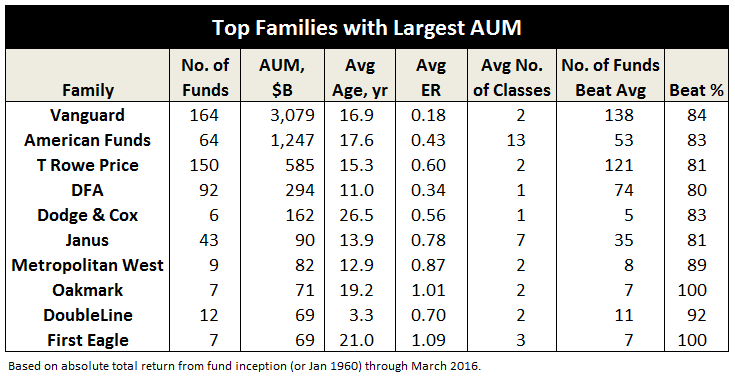 And, a nod to the young and unbeaten … a short list of top families where every fund beats its category average.
And, a nod to the young and unbeaten … a short list of top families where every fund beats its category average.
Gotham is led by renowned investor Joel Greenblatt. As for Grandeur Peak, David has been an outspoken champion since its inception. Below are its MFO Ratings (click image to enlarge):
MFO Fund Family Scorecard will soon be a regular feature on our Premium site, updated monthly, with downloadable tables showing performance and fund information for all families, like average ER, AUM, load, and shares classes.
Share Classes
Originally published in April 1, 2016 Commentary
Last month, David Offered Without Comment: Your American Funds Share Class Options. The simple table showing 18 share classes offered for one of AF’s fixed income funds generated considerable comment via Twitter and other media, including good discussion on the MFO Discussion Board.
We first called attention to excessive share classes in June 2014 with How Good Is Your Fund Family? (A partial update was May 2015.) American Funds topped the list then and it remains on top today … by far. It averages more than 13 share classes per unique fund offering.
The following table summarizes share class stats for the largest 20 fund management companies by assets under management (AUM) … through February 2016, excluding money market and funds less than 3 months old.
At the end of the day, share classes represent inequitable treatment of shareholders for investing in the same fund. Typically, different share classes reflect different expense ratios depending on initial investment amount, load or transaction fee, or association of some form, like certain 401K plans. Here’s a link to AF’s web page explaining Share Class Pricing Details. PIMCO’s site puts share class distinction front and center, as seen in its Products/Share Class navigator below, a bit like levels of airline frequent flyer programs:
We’ve recently added share class info to MFO Premium’s Risk Profile page. Here’s an example for Dan Ivascyn’s popular Income Fund (click on image to enlarge):
In addition to the various differences in 12b-1 fee, expense ratio (ER), maximum front load, and initial purchase amount, notice the difference in dividend yield. The higher ER of the no-load Class C shares, for example, comes with an attendant reduction in yield. And, another example, from AF, its balanced fund:
Even Vanguard, known for low fees and equitable share holder treatment, provides even lower fees to its larger investors, via so-called Admiral Shares, and institutional customers. Of course, the basic fees are so low at Vanguard that the “discount” may be viewed more as a gesture.
The one fund company in the top 20 that charges same expenses to all its investors, regardless of investment amount or association? Dodge & Cox Funds.
We will update the MFO Fund House Score Card in next month’s commentary, and it will be updated monthly on the MFO Premium site.
MFO Rating Metrics
Originally published in March 1, 2016 Commentary
When MFO introduced its rating system in June of 2013, it chose Martin Ratio as the principal performance rating metric. Martin is a risk adjusted return metric that is the ratio between excess return, which is the compounded annualized total return above risk free T-Bill return, divided by the so-called Ulcer Index, which is a measure of extent and duration of drawdown. Our friend Peter Matin formulated the Ulcer Index as described in An Alternative Approach to the Measurement of Investment Risk & Risk-Adjusted Performance.
For each fund category, like Large Growth or Moderate Allocation, the MFO Rating system divides funds into five groups or “quintiles” based on the risk adjusted return over selected evaluation periods. Funds with the highest Martin in each category are assigned a 5, while those with the lowest receive a 1.
While this approach suits many MFO readers just fine, especially having lived through two 50 percent equity market drawdowns in the past 15 years, others like Investor on the MFO Discussion Board, were less interested in risk adjusted return and wanted to see ratings based on absolute return. Others wanted to see ratings based on the more traditional risk adjusted Sharpe Ratio. (For more definitions, see A Look A Risk Adjusted Returns.)
It took a while, but subscribers on our MFO Premium site can now choose which rating metric they prefer, including multiple rating metrics simultaneously.
For example, since the start of the current market cycle in November 2007, which Small Cap funds have delivered the best absolute return (APR) and the best Martin Ratio and the best Sharpe Ratio? To find the answer, enter the selection criteria on the MFO MultiSearch tool, as depicted below (click image to enlarge), then hit the “Submit Search” button …
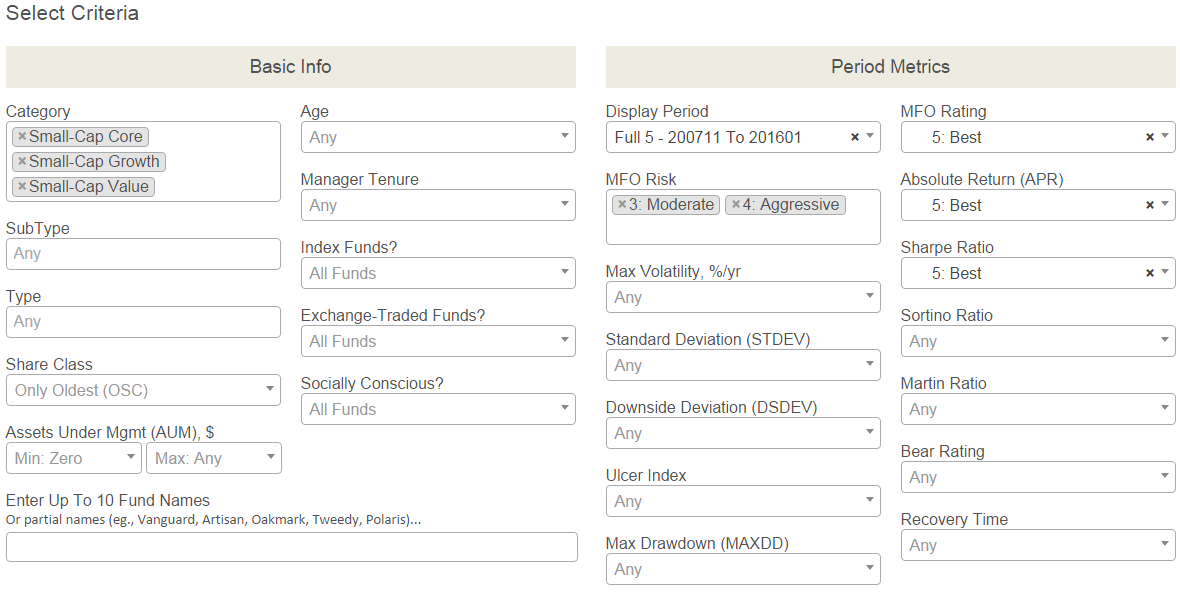 A total of 28 funds appear from the more than 9,000 unique funds in the MFO database. Here are the first 10, sorted by MFO Risk and then name:
A total of 28 funds appear from the more than 9,000 unique funds in the MFO database. Here are the first 10, sorted by MFO Risk and then name:
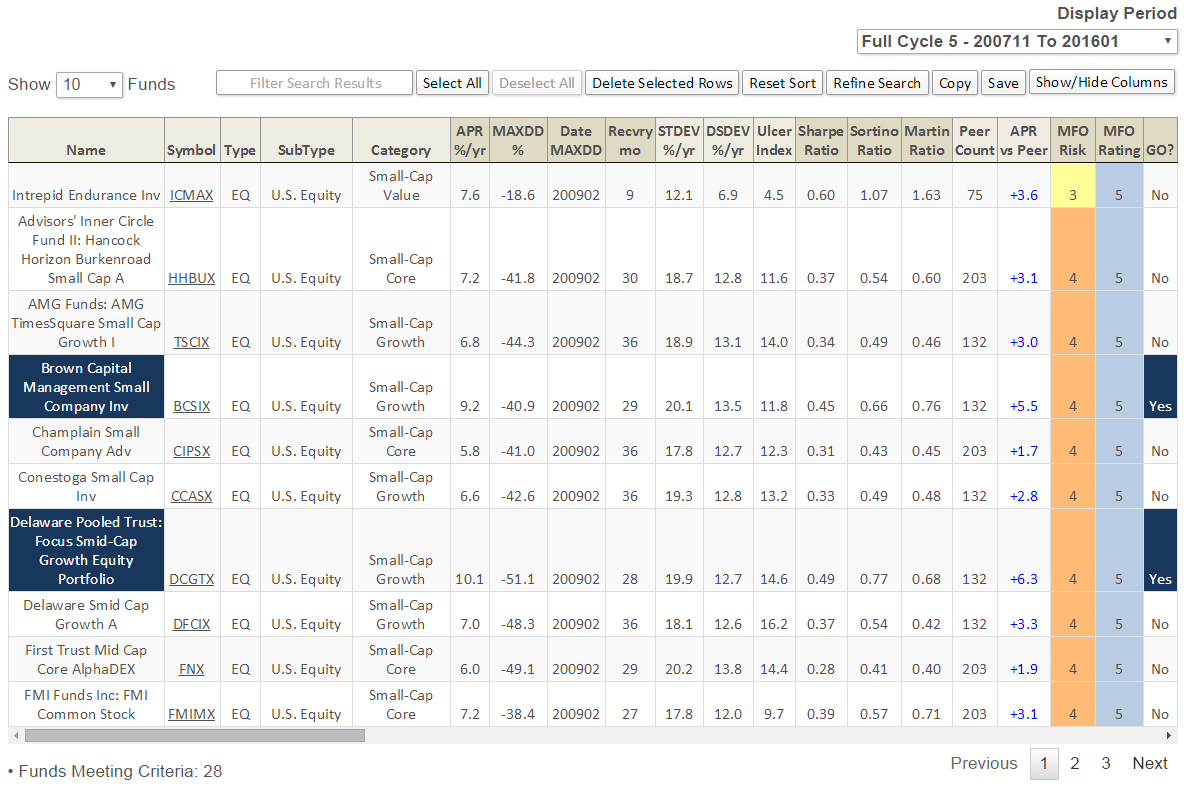 Notables include Brown Capital Mgmt Small Company (BCSIX), Champlain Small (CIPSX), Conestoga Small Cap (CCASX), and FMI Common Stock (FMIMX). The closed BCSIX is both an MFO Great Owl and Fund Alarm Honor Roll fund. It is also a Morningstar Gold Medal fund, while Silver goes to CIPSX and CCASX.
Notables include Brown Capital Mgmt Small Company (BCSIX), Champlain Small (CIPSX), Conestoga Small Cap (CCASX), and FMI Common Stock (FMIMX). The closed BCSIX is both an MFO Great Owl and Fund Alarm Honor Roll fund. It is also a Morningstar Gold Medal fund, while Silver goes to CIPSX and CCASX.
Intrepid Endurance (ICMAX) has the lowest risk rating with a MFO Risk of 3, which means this fund has historically carried volatility suited for investors with Moderate risk tolerance. Unlike other metrics in the MFO ratings system, and in fact the risk metric in Morningstar’s rating system, which assign risk relative to other funds in category, the MFO Risk metric assigns its rating based on volatility relative to the overall market.
The MFO MultiSearch tool now enables searches using more than 55 screening criteria, organized by Basic Info, Period Metrics, Composite Period Metrics, MFO Designations, Portfolio Characteristics, and Purchase Info. A list of current criteria can be found here.
Smallest, Shortest, Lowest
Originally published in February 1, 2016 Commentary
David invariably cuts to the chase when it comes to assessing mutual funds. It’s a gift he shares with us each month.
So, in evolving the MFO Premium site, he suggested we provide lists of funds satisfying interesting screening criteria to help users get the most from our search tools.
Last month we introduced two such lists: “Best Performing Rookie Funds” and “Dual Great Owl & Honor Roll Funds.”
This month our MultiSearch screener incorporates three more: “Smallest Drawdown Fixed Income Funds,” “Shortest Recovery Time Small Caps,” and “Lowest Ulcer Moderate Allocation Funds.”
Smallest Drawdown Fixed Income Funds generates a list of Fixed Income (e.g., Bond, Muni) funds that have experienced the smallest levels of Maximum Drawdown (MAXDD) in their respective categories. More specifically, they are in the quintile of funds with smallest MAXDD among their peers.
Looking back at performance since the November 2007, which represents the beginning of the current full market cycle, we find 147 such funds. Two top performing core bond funds are TCW Core Fixed-Income (TGCFX) and RidgeWorth Seix Total Return (SAMFX). The screen also uncovered notables like First Pacific Advisors’ FPA New Income (FPNIX) and Dan Ivascyn’s PIMCO Income (PIMIX).
Here are some risk/return metrics for these Fixed Income funds (click on images to enlarge):
TCW Core Fixed-Income (TGCFX) and RidgeWorth Seix Total Return (SAMFX)
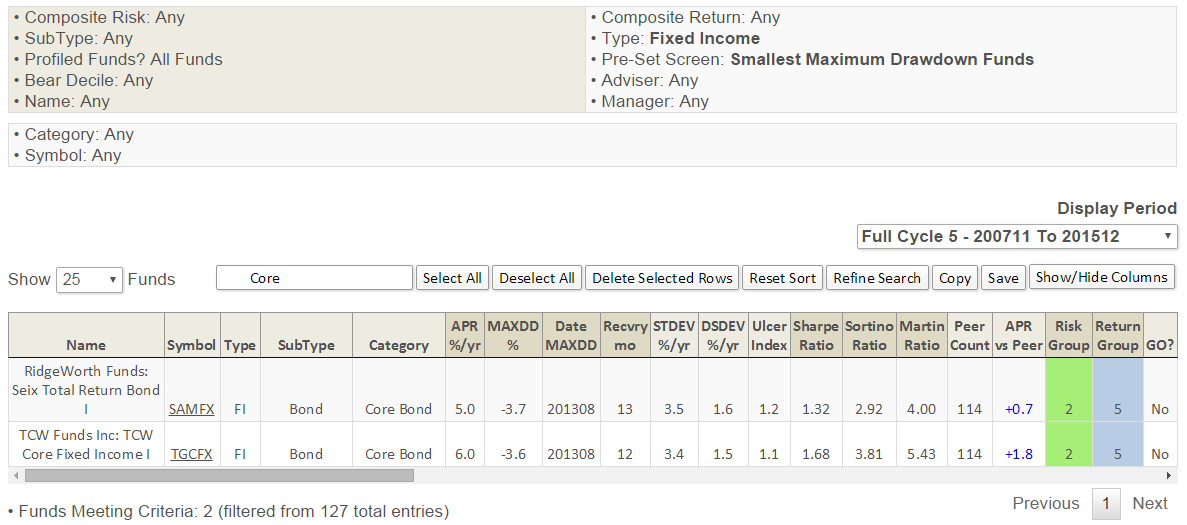
First Pacific Advisors’ FPA New Income (FPNIX)

PIMCO Income (PIMIX)
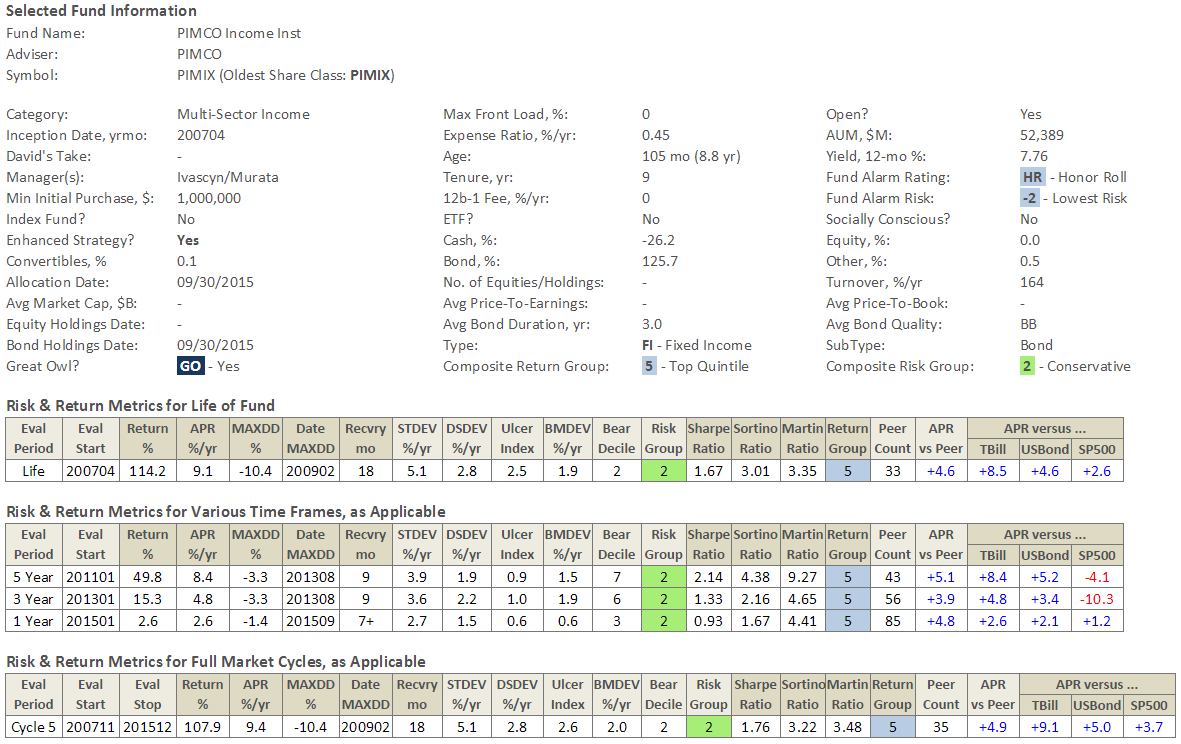

Shortest Recovery Time Small Caps generates a list of Small Cap (Small Core, Small Value, Small Growth) funds that have incurred shortest Recovery Times (number of months a fund retracts from previous peak) in their respective categories.
For Full Cycle 5, this screen produces 62 such funds through December 2015. Among the best performing funds with shortest Recovery Times, under 30 months, only one remains open and/or accessible: Queens Road Small Cap Value (QRSVX). It was profiled by David in April 2015.
Here’s a short list and risk/return numbers for QRSVX across various timeframes:
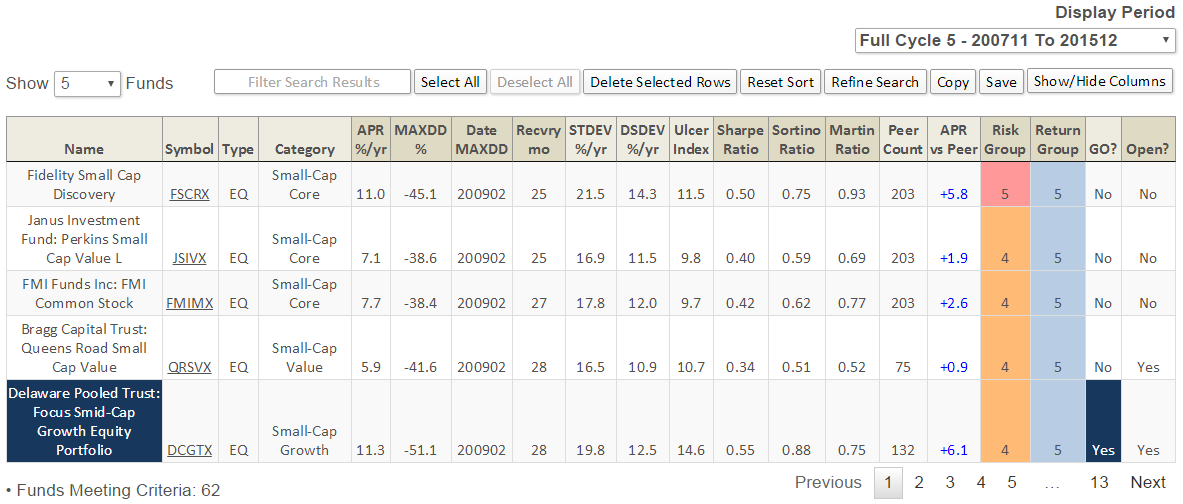
Queens Road Small Cap Value (QRSVX)
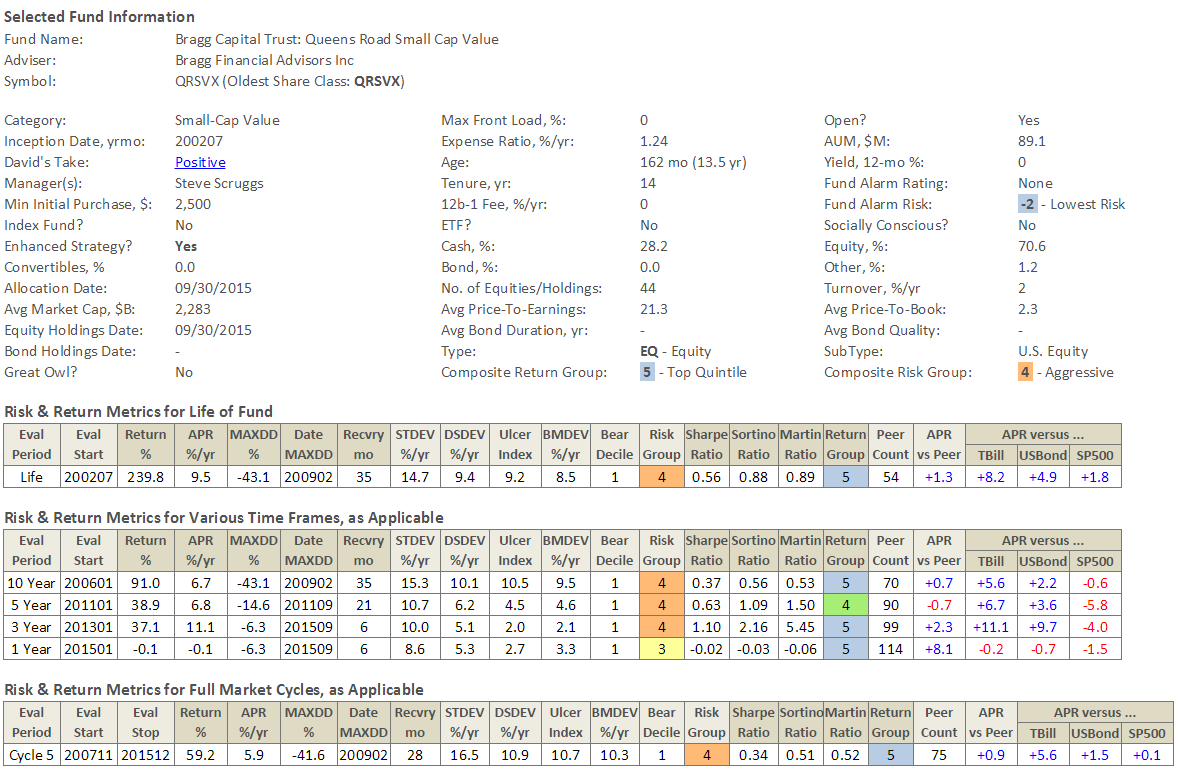
Lowest Ulcer Moderate Allocation Funds generates a list of Mixed Asset Moderate Allocation funds that have incurred the lowest Ulcer Indices in their respective categories.
Topping the list (fund with lowest UI) is James Balanced: Golden Rainbow (GLRBX), profiled last August :
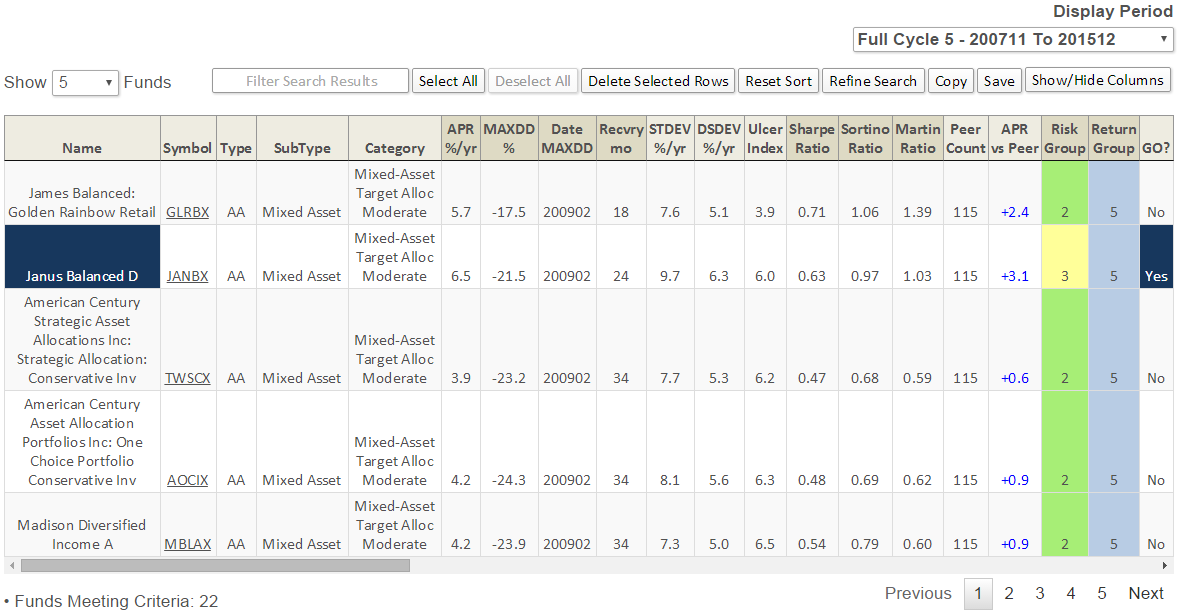
Premium Site Update
Originally published in January 1, 2016 Commentary
New to MFO Premium this month are several additions to the MultiSearch Tool, which now can screen our monthly fund database with some 44 performance metrics and other parameters. (Here are links to current Input and Output MultiSearch Parameter Lists.) The new additions include SubType (a kind of super category), exchange-traded fund (ETF) flag, Profiled Funds flag, and some initial Pre-Set Screens.
SubType is a broad grouping of categories. Lipper currently defines 144 categories, excluding money market funds. MFO organizes them into 9 subtypes: U.S. Equity, Mixed Asset, Global Equity, International Equity, Sector Equity, Commodity, Alternative & Other, Bond, and Municipal Bond funds. The categories are organized further into broader types: Fixed Income, Asset Allocation, and Equity funds. The MultiSearch Tool enables screening of up to 9 categories, 3 subtypes, or 2 types along with other criteria.
The Profiled Funds flag enables screening of funds summarized monthly on our Dashboard (screenshot here). Each month, David (and occasionally another member of MFO’s staff), typically provides in-depth analysis of two to four funds, continuing a FundAlarm tradition. Through November 2015, 117 profiles are available on MFO legacy site Funds page. “David’s Take” precariously attempts to distill the profile into one word: Positive, Negative, or Mixed.
The ETF flag is self-explanatory, of course. How many ETFs are in our November database? A lot! 1,716 of the 9,034 unique (aka oldest share class) funds we cover are ETFs, or nearly 19%. The most populated ETF subtype is Sector Equity with 364, followed by International Equity with 343, US Equity with 279, and Bonds with 264. At nearly $2T in assets under management (AUM), ETFs represent 12% of the market. Our screener shows 226 ETFs with more than $1B in AUM. Here is a summary of 3-year performance for top ten ETFs by AUM (click on image to enlarge):
The Pre-Set Screen option is simply a collection of screening criteria. The two initial screens are “Best Performing Rookie Funds” and “Both Great Owl and Honor Roll Funds.” The former generates a list of 160 funds that are between the age of 1 and 2 years old and have delivered top quintile risk adjusted return (based on Martin Ratio) since their inception. The latter generates a list of 132 funds that have received both our Great Owl distinction as well as Honor Roll designation. Here is a summary of 3-year performance for top ten such funds, again by AUM (click on image to enlarge) … it’s an impressive list:
Other Pre-Screens David has recommended include “moderate allocation funds with the best Ulcer Index, small caps with the shortest recovery times, fixed-income funds with the smallest MAXDD …” Stay tuned.
Along with the parameters above, new options were added to existing criteria in the MultiSearch Tool. These include 30, 40, and 50 year Age groups; a “Not Three Alarm” rating; and, a “0% Annual or More” Absolute Return setting.
Using the new “0% Annual or More” criterion, we can get a sense of how tough the past 12 months have been for mutual funds. Of the 8,450 funds across all categories at least 12 months old through November 2015, nearly 60% (4,835) returned less than 0% for the year. Only 36 of 147 moderate allocation funds delivered a positive return, which means nearly 75% lost money … believe it or not, this performance was worse than the long/short category.
A closer look at the long/short category shows 56 of 121 funds delivered positive absolute return. Of those, here are the top five based on risk adjusted return (Martin Ratio) … click on image to enlarge:
AQR’s rookie Long/Short Equity I (QLEIX) has been eye-watering since inception, as can be seen in its Risk Profile (click on images to enlarge):
While I’ve always been a fan of Cliff Asness and the strategies at AQR, I’m not a fan of AQR Funds, since experiencing unfriendly shareholder practices, namely lack of disclosure when its funds underperform … but nothing speaks like performance.
Whitebox Funds
I have also always been a fan of Andrew Redleaf and Whitebox Funds, which we featured in the March 2015 Whitebox Tactical Opportunities 4Q14 Conference Call and October 2013 Whitebox Tactical Opportunities Conference Call. David has remained a bit more guarded, giving them a “Mixed” profile in April 2013 Whitebox Market Neutral Equity Fund, Investor Class (WBLSX), April 2013.
This past month the Minneapolis-based shop decided to close its three open-end funds, which were based on its hedge-fund strategies, less than four years after launch. A person familiar with the adviser offered: “They were one large redemption away from exposing remaining investors to too great a concentration risk … so, the board voted to close the funds.” AUM in WBMIX had grown to nearly $1B, before heading south. According to the same person, Whitebox hedge funds actually attracted $2B additional AUM the past two years and that was where they wanted to concentrate their efforts.
The fund enjoyed 28 months (about as long as QLEIX is old) of strong performance initially, before exiting the Mr. Market bus. Through November 2015, it’s incurred 19 consecutive months of drawdown and a decline from its peak of 24.2%. Depicting its rise and fall, here is a Morningstar growth performance plot of WBMIX versus Vanguard’s Balanced Fund Index (VBINX), as well as the MFO Risk Profile (click on images to enlarge):
Ultimately, Mr. Redleaf and company failed to deliver returns across the rather short life span of WBMIX consistent with their goal of “the best endowments.” Ultimately, they also failed to deliver performance consistent with the risk tolerance and investment timeframe of its investors. Ultimately and unfortunately, there was no “path to victory” in the current market environment for the fund’s “intelligent value” strategy, as compelling as it sounded and well-intended as it may have been.
As always, a good discussion can be found on the MFO Board Whitebox Mutual Funds Liquidating Three Funds, along with news of the liquidations.
Year-end MFO ratings will be available on or about 4th business day, which would be January 7th on both our premium and legacy sites.
Category Averages
Originally published in December 1, 2015 Commentary
As promised, we’ve added a Category Averages tool on the MFO Premium page. Averages are presented for 144 categories across 10 time frames, including the five full market cycles period dating back to 1968. The display metrics include averages for Total Return, Annualized Percent Return (APR), Maximum Drawdown (MAXDD), MAXDD Recovery Time, Standard Deviation (STDEV, aka volatility), and MFO Risk Group ranking.
Which equity category has delivered the most consistently good return during the past three full market cycles? Consumer Goods. Nominally 10% per year. It’s also done so with considerably less volatility and drawdown than most equity categories.

One of the lower risk established funds in this category is Vanguard Consumer Staples Index ETF VDC. (It is also available in Admiral Shares VCSAX.) Here are its risk and return numbers for various time frames:
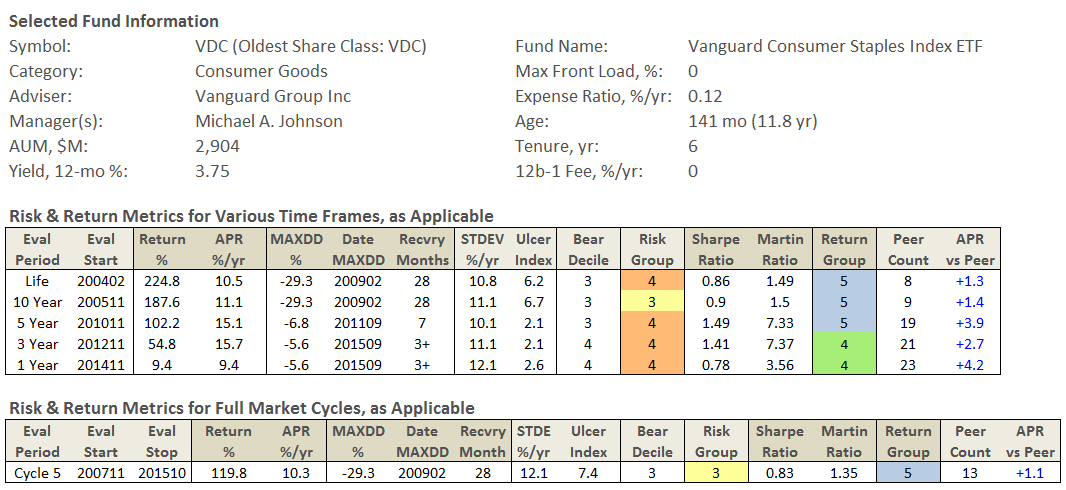
The new tool also enables you to examine Number of Funds used to compute the averages, as well as Fund-To-Fund Variation in APR within each category.
Comparing Lipper Ratings
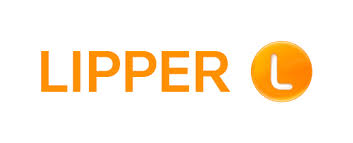 Originally published in November 1, 2015 Commentary
Originally published in November 1, 2015 Commentary
MFO recently started computing its risk and performance fund metrics and attendant fund ratings using the Lipper Data Feed Service for U.S. Open End funds. (See MFO Switches To Lipper Database.) These new data have now been fully incorporated on the MFO Premium beta site, and on the Great Owl, Fund Alarm, and Dashboard of Profiled Funds pages of our legacy Search Tools. (The Risk Profile and Miraculous Multi-Search pages will be updated shortly).
Last month we noted that the biggest difference MFO readers were likely to find was in the assigned classifications or categories, which are described in detail here. (Morningstar’s categories are described here, and Lipper nicely compares the two classification methodologies here.) Some examples differences:
- Lipper uses “Core” instead of “Blend.” So, you will find Large-Cap Growth, Large-Cap Core, and Large Cap Value.
- Lipper includes a “Multi-Cap” category, in addition to Large-Cap, Medium-Cap, and Small-Cap. “Funds that, by portfolio practice, invest in a variety of market capitalization ranges …” Examples are Vanguard Total Stock Market Index Inv (VTSMX), Auxier Focus Inv (AUXFX), and Bretton (BRTNX).
- Lipper does not designate an “Asset Allocation” category type, only “Equity” and “Fixed Income.” The traditional asset allocation funds, like James Balanced: Golden Rainbow Retail (GLRBX) and Vanguard Wellesley Income Inv (VWINX) can be found in the categories “Mixed-Asset Target Allocation Moderate” and “Mixed-Asset Target Allocation Conservative,” respectively.
- Lipper used “Core Bond” instead of say “Intermediate-Term Bond” to categorize funds like Dodge & Cox Income (DODIX).
- Lipper extends data back to January 1960 versus January 1962. Number of funds still here today that were here in January 1960? Answer: 72, including T Rowe Price Growth Stock (PRGFX).
A few other changes that readers may notice with latest update:
- Ratings for funds in all the commodities categories, like Commodities Agriculture, where previously we only included “Broad Basket.”
- Ratings for funds of leveraged and short bias categories, so-called “trading” funds.
- Ratings for 144 categories versus 96 previously. We continue to not rate money market funds.
- No ratings for funds designated as a “variable insurance product,” which typically cannot be purchased directly by investors. Examples are certain Voya, John Hancock, and Hartford funds.
- There may be a few differences in the so-called “Oldest Share Class (OSC)” funds. MFO has chosen to define OSC as share class with earliest First Public Offering (FPO) date. (If there is a tie, then fund with lowest expense ratio. And, if tied again, then fund with largest assets under management.)
Overall, the changes appear quite satisfactory.
Some Morningstar ETF Conference Observations
Originally published in October 1, 2015 Commentary Overcast and drizzling in Chicago on the day Morningstar’s annual ETF Conference opened September 29, the 6th such event, with over 600 attendees. The US AUM is $2 trillion across 1780 predominately passive exchange traded products, or about 14% of total ETF and mutual fund assets. The ten largest ETFs , which include SPDR S&P 500 ETF (SPY) and Vanguard Total Stock Market ETF (VTI), account more for nearly $570B, or about 30% of US AUM. Here is a link to Morningstar’s running summary of conference highlights.
Overcast and drizzling in Chicago on the day Morningstar’s annual ETF Conference opened September 29, the 6th such event, with over 600 attendees. The US AUM is $2 trillion across 1780 predominately passive exchange traded products, or about 14% of total ETF and mutual fund assets. The ten largest ETFs , which include SPDR S&P 500 ETF (SPY) and Vanguard Total Stock Market ETF (VTI), account more for nearly $570B, or about 30% of US AUM. Here is a link to Morningstar’s running summary of conference highlights.
Joe Davis, Vanguard’s global head of investment strategy group, gave a similarly overcast and drizzling forecast of financial markets at his opening key note, entitled “Perspectives on a low growth world.” Vanguard believes GDP growth for next 50 years will be about half that of past 50 years, because of lack of levered investment, supply constraints, and weak global demand. That said, the US economy appears “resilient” compared to rest of world because of the “blood -letting” or deleveraging after the financial crisis. Corporate balances sheets have never been stronger. Banks are well capitalized.
US employment environment has no slack, with less than 2 candidates available for every job versus more than 7 in 2008. Soon Vanguard predicts there will be just 1 candidate for every job, which is tightest environment since 1990s. The issue with employment market is that the jobs favor occupations that have been facilitated by the advent of computer and information technology. Joe believes that situation contributes to economic disparity and “return on education has never been higher.”
Vanguard believes that the real threat to global economy is China, which is entering a period of slower growth, and attendant fall-out with emerging markets. He believes though China is both motivated and has proven its ability to have a “soft landing” that relies more on sustainable growth, if slower, as it transitions to more of a consumer-based economy.
Given the fragility of the global economy, Vanguard does not see interest rates being raised above 1% for the foreseeable future. End of the day, it estimates investors can earn 3-6% return next five year via a 60/40 balanced fund.
J. Martijn Cremers and Antti Petajisto introduced a measure of active portfolio management in 2009, called Active Share, which represents the share of portfolio holdings that differ from the benchmark index holdings. A formal definition and explanation can be found here (scroll to bottom of page), extracted from their paper “How Active Is Your Fund Manager? A New Measure That Predicts Performance.”
Not everybody agrees that the measure “Predicts Performance.” AQR’s Andrea Frazzini, a principal on the firm’s Capital Management Global Stock Selection team, argued against the measure in his presentation “Deactivating Active Share.” While a useful risk measure, he states it “does not predict actual fund returns; within individual benchmarks, it is as likely to correlate positively with performance as it is to correlate negatively.” In other words, statistically indistinguishable.
AQR examined the same data as the original study and found the same quantitative result, but reached a different implication. Andrea believes the 2% higher returns versus the benchmark the original paper touted is not because of so-called high active share, but because the small cap active managers during the evaluation period happened to outperform their benchmarks. Once you break down the data by benchmark, he finds no convincing argument.
He does believe it represents a helpful risk measure. Specifically, he views it as a measure of activity. In his view, high active share means concentrated portfolios that can have high over-performance or high under-performance, but it does not reliably predict which.
He also sees its value in helping flag closest index funds that charge high fees, since index funds by definition have zero active share.
Why is a large firm like AQR with $136B in AUM calling a couple professors to task on this measure? Andrea believes the industry moved too fast and went too far in relying on its significance.
The folks at AlphaArchitect offer up a more modest perspective and help frame the debate in their paper, ”The Active Share Debate: AQR versus the Academics.”
 Charles Ellis, renowned author and founder of Greenwich Associates, gave the lunchtime keynote presentation. It was entitled “Falling Short: The Looming Problem with 401(k)s and How To Solve It.”
Charles Ellis, renowned author and founder of Greenwich Associates, gave the lunchtime keynote presentation. It was entitled “Falling Short: The Looming Problem with 401(k)s and How To Solve It.”
He started by saying he had “no intention to make an agreeable conversation,” since his topic addressed the “most important challenge to our investment world.”
The 401(k) plans, which he traces to John D. Rockefeller’s gift to his Standard Oil employees, are falling short of where they need to be to support an aging population whose life expectancy keeps increasing.
He states that $110K is the median 401(k) plus IRA value for 65 year olds, which is simply not enough to life off for 15 years, let alone 25.
The reasons for the shortfall include employers offering a “You’re in control” plan, when most people have never had experience with investing and inevitably made decisions badly. It’s too easy to opt out, for example, or make an early withdrawal.
The solution, if addressed early enough, is to recognize that 70 is the new 65. If folks delay drawing on social security from say age 62 to 70, that additional 8 years represents an increase of 76% benefit. He argues that folks should continue to work during those years to make up the shortfall, especially since normal expenses at that time tend to be decreasing.
He concluded with a passionate plea to “Help America get it right…take action soon!” His argument and recommendations are detailed in his new book with co-authors Alicia Munnell and Andrew Eschtruth, entitled “Falling Short: The Coming Retirement Crisis and What to Do About It.”
Thinking outside the model is hazardous to one’s wealth…
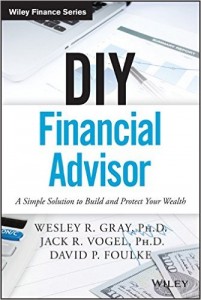 Originally published in October 1, 2015 Commentary
Originally published in October 1, 2015 Commentary
The title comes from the AlphaArchitect’s DIY Investing site, which is led by Wesley Gray. We profiled the firm’s flagship ValueShares US Quantitative Value ETF (QVAL) last December. Wes, along with Jack Vogel and David Foulke, recently published the Wiley Finance Series book, “DIY Finanical Advisor – A Simple Solution to Build and Protect Your Wealth.” It’s a great read.
It represents a solid answer to the so-called “return gap” problem described by Jason Hsu of Research Associates during Morningstar’s ETF Conference yesterday. Similar to and inspired by Morningstar’s “Investor Return” metric, Jason argues that investors’ bad decisions based on performance chasing and bad timing account for a 2% annualized short-fall between a mutual fund’s long-term performance and what investors actually receive. (He was kind enough to share his briefing with us, as well are his background position paper.)
“Investors know value funds achieve a premium, but they are too undisciplined to stay the course once the value fund underperforms the market.” It’s not just retail investors, Jason argues the poor behavior has actually been institutionalized and at some level may be worst for institutional investors, since their jobs are often based on short-term performance results.
DIY Financial Advisor opens by questioning society’s reliance on “expert opinion,” citing painful experiences of Victor Niederhoffer, Meredith Whitney, and Jon Corzine. It attempts to explain why financial experts often fail, due various biases, overconfidence, and story versus evidence-based decisions. The book challenges so-called investor myths, like…
- Buffett’s famous advice: “It’s far better to buy a wonderful company at a fair price than a fair company at the wonderful price.”
- Economic growth drives stock returns.
- Payout superstition, where observers predict that lower-dividend payout ratios imply higher earnings growth.
In order to be good investors, the book suggests that we need to appreciate our natural preference for coherent stories over evidence that conflicts with the stories. Don’t be the pigeon doing a “pellet voodoo dance.”
It advocates adoption of simple and systematic investment approaches that can be implemented by normal folks without financial background. The approaches may not be perfect, but they have been empirically validated, like the capture of value and momentum premiums, to work “for a large group of investors seeking to preserve capital and capture some upside.”
Wes details how and why Harry Markowitz, who won the Nobel Prize in 1990 for his groundbreaking work in portfolio selection and modern portfolio theory, used a simple equal-weight 50/50 allocation between bond and equities when investing his own money.
The book alerts us to fear, greed, complexity, and fear tactics employed by some advisors and highlights need for DIY investors to examine fees, access/liquidity, complexity, and taxes when considering investment vehicles.
It concludes by stating that “as long as we are disciplined and committed to a thoughtful process that meets our goals, we will be successful as investors. Go forth and be one of the few, one of the proud, one of the DIY investors who took control of their hard-earned wealth. You won’t regret the decision.”
As with Wes’ previous book, Quantitative Value: A Practitioner’s Guide to Automating Intelligent Investment and Eliminating Behavioral Errors, DIY Financial Advisor is chock full of both anecdotes and analytical results. He and his team at AlphaArchitect continue to fight the good fight and we investors remain the beneficiaries.
MFO Switches To Lipper Database
 Originally published in October 1, 2015 Commentary
Originally published in October 1, 2015 Commentary
In weeks ahead, MFO will begin using a Lipper provided database to compute mutual fund risk and return metrics found on our legacy Search Tools page and on the MFO Premium beta site.
Specifically, the monthly Lipper DataFeed Service provides comprehensive fund overview details, expenses, assets, and performance data for US mutual funds, ETFs, and money market funds (approximately 29,000 fund share classes).
Lipper, part of Thomson Reuters since 1998, has been providing “accurate, insightful, and timely collection and analysis of fund data” for more than 40 years. Its database extends back to 1960.
The methodologies MFO uses to compute its Great Owl funds, Three Alarm and Honor Roll designations, and Fund Dashboard of profiled funds will remain the same. The legacy search tool site will continue to be updated quarterly, while the premium site will be updated monthly.
Changes MFO readers can expect will be 1) quicker posting of updates, typically within first week of month, 2) more information on fund holdings, like allocation, turnover, market cap, and bond quality, and 3) Lipper fund classifications instead of the Morningstar categories currently used.
A summary of the Lipper classifications or categories can be found here. The more than 150 categories are organized under two main types: Equity Funds and Fixed Income Funds.
The Equity Funds have the following sub-types: US Domestic, Global, International, Specialized, Sector, and Mixed Asset. The Fixed Income Funds have: Short/Intermediate-Term U.S. Treasury and Government, Short/Intermediate-Term Corporate, General Domestic, World, Municipal Short/Intermediate, and Municipal General.
The folks at Lipper have been a pleasure to work with while evaluating the datafeed and during the transition. The new service supports all current search tools and provides opportunity for content expansion. The MFO Premium beta site in particular features:
- Selectable evaluation periods (lifetime, 20, 10, 5, 3, and 1 year, plus full, down, and up market cycles) for all risk and performance metrics, better enabling direct comparison.
- All share classes, not just oldest.
- More than twenty search criteria can be selected simultaneously, like Category, Bear Decile, and Return Group, plus sub-criteria. For example, up to nine individual categories may be selected, along with multiple risk and age characteristics.
- Compact, sortable, exportable search table outputs.
- Expanded metrics, including Peer Count, Recovery Time, and comparisons with category averages.
Planned content includes: fund rankings beyond those based on Martin ratio, including absolute return, Sharpe and Sortino ratios; fund category metrics; fund house performance ratings; and rolling period fund performance.
Checking in on MFO’s 20-year Great Owls
Originally published in September 1, 2015 Commentary
MFO first introduced its rating system in the June 2013 commentary. That’s also when the first “Great Owl” funds were designated. These funds have consistently delivered top quintile risk adjusted returns (based on Martin Ratio) in their categories for evaluation periods 3 years and longer. The most senior are 20-year Great Owls. These select funds have received Return Group ranking of 5 for evaluation periods of 3, 5, 10, and 20 years. Only about 50 funds of the 1500 mutual funds aged 20 years or older, or about 3%, achieve the GO designation. An impressive accomplishment.
Below are the current 20-year GOs (excluding muni funds for compactness, but find complete list here, also reference MFO Ratings Definitions.)
Of the original 20-year GO list of 47 funds still in existence today, only 19 remain GOs. These include notables: Fidelity GNMA (FGMNX), PIMCO Foreign Bond – USD-Hedged I (PFORX), James Balanced: Golden Rainbow R (GLRBX), T. Rowe Price Capital Appreciation (PRWCX), Vanguard Wellington Inv (VWELX), Meridian Growth Legacy (MERDX), and Hennessy Gas Utility Investor (GASFX).
The current 20-year GOs also include 25 Honor Roll funds, based on legacy Fund Alarm ranking system. Honor Roll funds have delivered top quintile absolute returns in its category for evaluation periods of 1, 3, and 5 years. These include: AMG Managers Interm Dur Govt (MGIDX), PIMCO Foreign Bond – USD-Hedged I (PFORX), James Balanced: Golden Rainbow R (GLRBX), T. Rowe Price Capital Appreciation (PRWCX), and T. Rowe Price Mid-Cap Growth (RPMGX).
A closer look at performance of the original list of 20-year GOs, since they were introduced a little more than two years ago, shows very satisfactory performance overall, even with funds not maintaining GO designation. Below is a summary of Return Group rankings and current three-year performance.


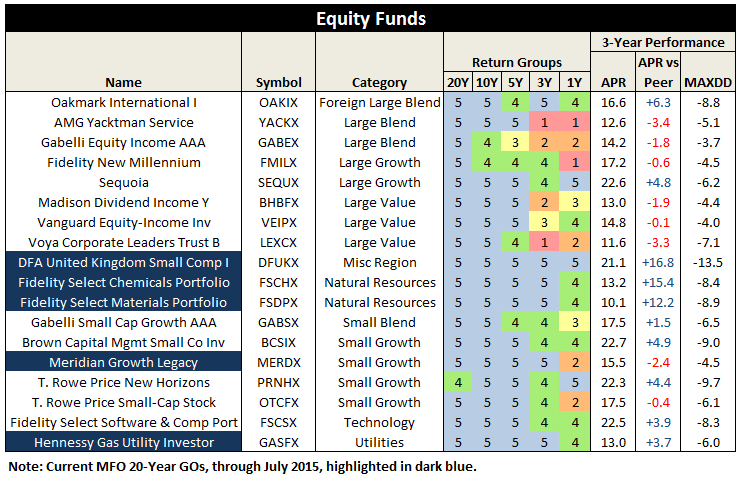
Of the 31 funds in tables above, only 7 have underperformed on a risk adjusted basis during the past three years, while 22 have outperformed.
Some notable outperformers include: Vanguard Wellesley Income Inv (VWINX), Oakmark International I (OAKIX), Sequoia (SEQUX), Brown Capital Mgmt Small Co Inv (BCSIX), and T. Rowe Price New Horizons (PRNHX).
And the underperformers? Waddell & Reed Continental Inc A (UNCIX), AMG Yacktman (YACKX), Gabelli Equity Income AAA (GABEX), and Voya Corporate Leaders Trust (LEXCX).
A look at absolute returns show that 10 of the 31 underperformed their peers by an average of 1.6% annualized return, while the remaining 21 beat their peers by an average of 4.8%.
Gentle reminder: MFO ratings are strictly quantitative and backward looking. No accounting for manager or adviser changes, survivorship bias, category drift, etc.
Will take a closer look at the three-year mark and make habit of posting how they fared over time.
James Balanced Golden Rainbow Fund (GLRBX/GLRIX), August 2015
Objective and Strategy
The James Balanced Golden Rainbow Fund (GLRBX/GLRIX) seeks to provide total return through a combination of growth and income and preservation of capital in declining markets.
Under normal circumstances, the diversified James Balanced Golden Rainbow Fund invests primarily in undervalued domestic equities of companies with various market capitalizations and in high-quality (S&P’s rating of BBB or better) fixed income securities of various durations. At end of June 2015, the fund was 55% equity, 42% fixed income, and 3% cash equivalent. Median market cap was $7.6B (mid-cap, but with average about $15B) and average bond duration was 4.3 years.
The fund will normally hold both equity securities and fixed income securities, with at least 25% of its assets in equity and at least 25% of its assets in fixed income. Its broad, go-anywhere (if long only) charter enables it to go to 100% cash equivalents for short periods or even 50% for longer periods, although the adviser usually finds better opportunities than cash. It will hold foreign equities, currently just a couple percent, but probably never more than 10% and usually in form of ETFs or ADRs. Similarly, it can hold sovereign debt.
GLRBX’s allocation closely echoes the simple philosophy championed by Ben Graham in the Intelligent Investor and similarly touted by famed investors Harry Markowitz and John Bogle. Nominally 50/50 equity/fixed allocation, but then tailored based on investor temperament and/or market assessment, but never less than 25% in either. GLRBX targets defensively minded long-term investors.
Here’s a look back at the fund’s allocation since inception, which rarely deviates more than about 10% from the 50/50 split:
The fund attempts to provide total return in excess of the rate of inflation over the long term (3 to 5 years).
Adviser
James Investment Research (JIR), Inc. is the fund’s adviser. Dr. Francis E. James is the controlling share-holder. In 1972, he and his wife, Iris, started JIR in the bedroom of their son, David, with only $20K AUM. Their lofty goal was to garner $10M from family, friends and business relationships, which they considered the threshold AUM to enable purchasing a computer.
A spokesman for the firm explains that marketing has never been the main focus: “It has always been doing research, taking care of our clients and managing their funds wisely.” Fortunately, performance of the early fund (a precursor to GLRBX that was a comingled trust fund managed by Dr. James for Citizen’s Federal Savings and Loan) was satisfactory and the conservative nature of the investments attracted investors. It grew to about $100 million in size in 1983. The name “Golden Rainbow” comes from the original S&L’s logo.
Today the firm manages $6.5B for individuals, businesses, and endowments, as shown below. The preponderance is in GLRBX. It is a conservative allocation fund with $4.2B AUM, established formally in 1991. It is the firm’s oldest fund and flagship. JIR advises five other mutual funds “to provide diversification in our James Advantage Funds (aka James Funds) family.” These other funds appear to be offered to more aggressive investors for at least part of their portfolios, as capital preservation in declining markets is a secondary goal.
The firm has 19 full-time employees and two part-time. Since 1978, JIR practices profit sharing with its employees. “Cash profits shared last year were in excess of 45%, not including pension contributions.”
James maintains a PO Box in Alpha, Ohio, but is actually located in nearby Xenia, which is about 10 miles east of Dayton, near Wright Patterson Air Force Base, Wright Brother’s Memorial, and Wright State University. “It is a quiet place to do research and it is far from Wall Street. We don’t tend to follow the herd and we can keep our independent approach a little easier than in a big city. We operate on 35 acres in the woods, and it helps to keep stress levels lower and hopefully helps us make wiser decisions for our clients.”
Managers
GLRBX is managed by a 9 member investment committee. Average tenure is over 20 years with the firm. Three are James’ family members: founder Dr. Frank James, CEO Barry James, and Head of Research David James. The committee makes the determination of allocation, stocks approved for purchase or sale, and bond duration. Day to day, any member handles implementation of the committee’s guidance. Nominally the fund is managed by a nine-person team, but day-to-day responsibility falls to Brian Culpepper (since 1998), Brian Sheperdson (since 2001), Trent Dysert (since 2014) and Moustapha Mounah (since 2022).
Dr. James is 83 years old. He served in the Air Force for 23 years, achieving the rank of Colonel and headed the Department of Quantitative Studies at the Air Force Institute of Technology. He received his Ph.D. from RPI where his thesis was “The Implications of Trend Persistency in Portfolio Management,” which challenged the idea that stocks move at random and formed the basis for technical analysis still employed by the firm today. Basically, he observed that stock price movements are not random and trends persist. He remains engaged with the firm, does research, and provides mentoring to the team on a regular basis.
Barry James also served as a pilot in the Air Force, receiving degrees from both Air Force Academy and Boston University, returning full time to James in 1986. All other members of the investment team have at least one degree from colleges or universities located in Ohio, except David James who holds no formal degree, but is a CFA.
Strategy capacity and closure
GLRBX has never closed. The firm believes capacity is $10-15B, based on its studies of expected performance and trading limitations. So, plenty of capacity remaining. That said: “We think having controlled growth is the key to being able to sustain performance. We aren’t trying to become the biggest because we don’t want to sacrifice the current client and their results just to add another dollar to the fund. At the same time, we believe we have something that many folks want and need and we don’t want to turn them away if we can help them.”
James admits that it focuses on advisers versus retail investors because it wants long-term relationships and it wants to avoid maintaining a large marketing staff.
To put GLRBX in perspective, its AUM is just 1% of Vanguard Wellington Wellesley (VWINX) fund, which maintains an average market cap of about $90B in its equity portfolio.
Active share
GLRBX reports against a blended index comprising 25% S&P 500, 25% Russell 2000, and 50% Barclays Capital Intermediate Government/Credit Bond indices. In practice, however, it does not follow a benchmark and does not compute the “active share” metric, which measures the degree to which a fund’s portfolio differs from the holdings of its benchmark portfolio. So, the metric is not particularly applicable here.
JIR’s David James, Director of Research, explains: “The fund deviates greatly and on purpose from the sector weightings of both these indexes. Typically this leads us to be better diversified than the benchmark which often overweights technology and finance sectors. Similarly, the fund would show up with a high “active share” as we presently have 141 individual equity holdings compared to close to 2,500 for the combined S&P 500 / Russell 2000 Indexes.”
We asked our friends at Alpha Architect to assess the GLRBX portfolio with their on-line Active Share Calculator (coming soon) and sure enough, they calculated 94.2%.
Management’s Stake in the Fund
GLRBX represents the model for how fund management should maintain significant “skin in the game” and align its interests with those of shareholders. All long-time trustees and the entire team of 9 portfolio managers (the fund’s investment committee) are invested in the fund, plus the adviser’s retirement plan is invested in the fund. Per the latest SAI, dated November 14, 2014, the four trustees have more the $100K in the fund (two others just elected are expected to hold similar amounts). The table below represents holdings by the investment committee members:
Opening date
July 1, 1991 for investor share class (GLRBX) and March 2, 2009 for institutional share class (GLRIX).
Minimum investment
When investing directly with James, just $2K for a GLRBX individual account, just $500 for a retirement account, and just $50 with an automatic investment plan. Institutional shares also have a friendly $50K minimum by industry standards.
Just as a sample, Schwab offers GLRBX as a No Load/No Fee fund, with slightly higher minimums ($2.5K individual/$1K retirement) but imposes a short-term redemption fee. Similarly, Schwab offers GLRIX but with transaction fee and $100K minimum, but no short-term redemption fee.
Expense ratio
The retail shares are 1.21% and the Institutional shares are 0.96% on assets of $432.6 million, as of July 2023.
——————————————————————————————————————————————
GLRBX charges a 1.01% expense fee annually, per its latest prospectus dated 11/01/2014, which is about 0.25% below industry average for the conservative allocation category. Its fee for active management is 0.66%.
Unfortunately like most of the industry, James still imposes 0.25% 12b-1 distribution and/or shareholder servicing fee and still maintains two share classes. Most of the 12b-1 fees are paid to the broker-dealers, like Schwab, who sell fund shares. Multiple share classes mean shareholders pay different expenses for the same fund, typically due to initial investment amount, transaction fee, or association of some form.
Institution shares (GLRIX) do not include the 12b-1 fee, resulting in a low 0.76% expense fee annually.
James imposes no loads.
On practice of soft dollars, which is essentially a hidden fee that allows advisers to pay higher commissions to broker-dealers to execute trades in exchange for things like research databases, James’ SAI allows it. Its Chief Compliance Officer, Lesley Ott, explains: “The language in our SAI permits soft dollars; however, it is our policy to not use them. Per advice from counsel, the language in the SAI is intended to be broad in nature even though we may not engage in specific practices.”
On page 19 of the firm’s public disclosure of qualifications and practices (the so-called Part 2A of Form ADV: Firm Brochure) it states: “JIR does not have any soft-dollar arrangements and does not receive any soft-dollar benefits.” In fact, it is James’ practice to not pay for outside research; rather it conducts most of its research in-house.
Comments
The track record since inception for GLRBX is enviable by any measure and across any time frame.
Through June 2015, it is an MFO 20-year Great Owl, which means its shareholders have enjoyed top quintile risk adjusted returns based on Martin Ratio for the past 20, 10, 5, and 3 year periods. It is the only 20-year Great Owl in the conservative allocation category. It is also on the MFO Honor Roll, which means that it has delivered top quintile absolute returns in its category over the past 5, 3, and 1 year periods.
Though it is a Morningstar 5 star fund based on quantitative past performance, the fund is not covered by Morningstar analysts.
Here are its risk/return metrics across various evaluation periods through June 2015:
Here’s how it compares with notable peers during the current market cycle (Cycle 5 in table above), beginning November 2007, which includes the housing bubble:
Here’s how it compares with during the market in cycle from September 2000 through October 2007 (Cycle 4 in table above), which includes the tech bubble:
True to its objective across all these evaluation periods, the fund has delivered very satisfactory total returns while minimizing volatility and drawdown.
How does it do it?
James believes it is better to try and anticipate rather than react to the market. In doing so, it has developed a set of risk indicators and stock selection factors to set allocation and portfolio construction. James has quantified these indicators every week since 1972 in disciplined fashion to help reduce 1) emotional moves, and 2) base actions on facts and current data.
When change to the portfolio does occur, it is done gradually. “We don’t jump from one extreme to the other in terms of allocation, we use the salami approach, taking a slice into or out of the market and then watching our indicators and continuing the process if they keep the same level of bullishness or bearishness.”
The risk measures and stock selection factors include a combination of macro-economic, sector analysis, company fundamental, and even market and stock technical analysis, like moving averages, as depicted below.
Once the investment committee establishes allocation, capitalization, and sector weightings, the universe of about 8500 stocks tracked in Zack’s database, including those on Russell 2000 and S&P 500, are ranked based on three categories: relative valuation/sentiment (50%), positive and growing earnings (35%), and relative price strength (15%). The top ranked stocks then get reviewed more qualitatively by a team of 3 before being debated and voted on for inclusion by the investment committee. “A simple majority rules, with committee members voting in reverse order of seniority, to avoid undue influence by senior management.”
The disciplined risk management process is further depicted here:
In his book, 7 Timeless Principles of Investing, Barry James discusses how the decision to sell is more important than the decision to buy. James never enters a position without having the conviction to hold a stock a minimum of six month. But, more importantly and distinct than say deep-value investors, like Bruce Berkowitz or even Dodge & Cox, James will exit a position based on technical analysis alone. Not drawdown limits per se but technicals none the less.
Barry James explains: “We will sell a stock when it no longer offers good risk/reward return, which could be a change in fundamentals, but also weak price strength. While individual investors may often hang-on to poor performing stocks in hopes of a come-back, we see hanging-on to losers as an opportunity cost … we’ve developed the discipline to simply not do that.” Basically, fundamentals being equal, James would rather dump the losing stock for a stock with stronger price strength.
On share-holder friendliness, the company does a lot right: skin-in-the-game through substantial investment in the fund by all managing principals and directors of the trust, the firm’s employee retirement plan is in the fund, weekly email with updates on allocation decisions, quarterly commentary newsletters, frequent special reports including an annual financial outlook, no loads, relatively low fees, and a published Guiding Principles document.
The Guiding Principles document covers the firm’s mission, ethical standards, focus, and the importance of following the “Golden Rule” of treating others as one would like others to treat oneself. But the firm goes a step further by aligning these principles as “God Honoring” and applies the biblical reference of “Seek First the Kingdom of God.”
The firm’s vision articulated by James Barry, in fact, is “…best investment firm in US by striving to follow God Honoring Principles…we will spearhead a dramatic improvement in reputation of our industry.”
Mr. James’s religious faith clearly informs his investment practice. When asked if the association ever caused potential investors to feel awkward or even alienated, he states, “People will tell me that I don’t believe what you believe but I’m glad you do.”
Unlike socially responsible or so-called ESG funds, James applies no screen to restrict investments to firms practicing similar principles or of any religious association.
(James does act as a sub-adviser for the Timothy Plan Growth & Income Fund TGIAX, which is part of The Timothy Plan family of mutual funds for “biblically responsible investing”. These funds avoid “investing in companies that are involved in practices contrary to Judeo-Christian principles.” This family ranks in the bottom quintile on MFO’s Fund Family Score Card due in part at least to indefensible front-loads and high expense ratios.)
James is a family business and succession planning is clear and present from Dr. James to Barry and David. Beyond that, a grandson-in-law and a grandson are getting experience at the firm and in the brokerage business. A spokesman explains: “Our intent is for the firm to remain independent in the years ahead and estate planning has been done to keep the business in the family’s hands.”
Bottom Line
At some level, all actively managed funds try to anticipate the future and position accordingly. By studying past results and identifying persistent premiums, like value or small cap stocks. By studying company fundamentals to find under-appreciated stocks of high quality companies. By finding pricing displacements or inefficiencies in the market and attempting to capitalize with say value arbitrage trades. By anticipating macro-economic events or recognizing trends in the market.
James combines several of these approaches with its flagship fund for setting allocations, sector weightings, bond duration targets, equity selection, and portfolio construction in a way that mitigates risk, protects against downside, while still delivering very satisfactory returns. Given its track record, relatively small size, and disciplined implementation, there is no reason to believe it will not keep meeting its investment objective. It definitely deserves to be on the short list of easy mutual funds to own for defensive minded investors.
Fund website
James Advantage Funds maintains a decent website, which includes fund regulatory documentation, past performance, market outlooks, quarterly and special reports. Similarly, more information about the adviser can be found at James Investment Research.


